I came upon this comment by artist Julie Mehretu on social media and think this is how I look at my research for making a body of work:”….that’s what I’m interested in: the space in between, the moment of imagining what is possible and yet not knowing what that is.” Julie Mehretu
Project One: Why Write?
In the introduction, it is suggested that Part One of this course will help me to consider the benefits of research and support me in mapping my area of interest. I will use reflection (and review/evaluation/questioning, propose ideas, and seek relevant ideas) in my learning and thinking. The outcome of this course will be a piece of academic writing – the Contextual Study. I would very much like to reach the point where my work would be evidence of my research. I would like it to be based in knowledge (the proof of the outcomes of the making?) It should be gained by making, reading and thinking in the research. I am very wary that words and language are not always transparent enough to convey knowledge and or understanding, but it could help to think analytic or problem-focussed. Making a work or a body of work should also be seen as part of the knowledge, which I would see as a way of knowing, thinking and doing.
I am trying to visualize this outcome by focusing on the Verblist and ideas of the artist, Richard Serra. My learning in Understanding Visual Culture at an earlier study level was that this artist concentrated on creativity and the process, not on the end product. I ask myself if his work as a process shows something about repetitive actions when making or as a systematic approach. I think he is not delivering experimenting and unintentional outcomes – he intentionally shows (shares) work and process being repeated to understand how to work with materials and for the viewer to see his thinking in action. So in that way, his making is his research (results), and the work is not about intention, which
When it comes to writing and making art, I think ideas come as images and words, even before we start making. But I also think of site-specific when I look at his work – for me, my mushrooms could relate as the surroundings in which they will be placed could become part of the aesthetic. I am not sure if I can say my work will be compromised if not connected to the site, but some results where I show mushrooms growing into an object might be. I also feel such a site will give the viewer a different experience – as it is very significant to the making of the planned sculptural objects, and one gets to experience almost what it feels to ‘be a fungi growing’ in the ground/ on a tree— in its environment.
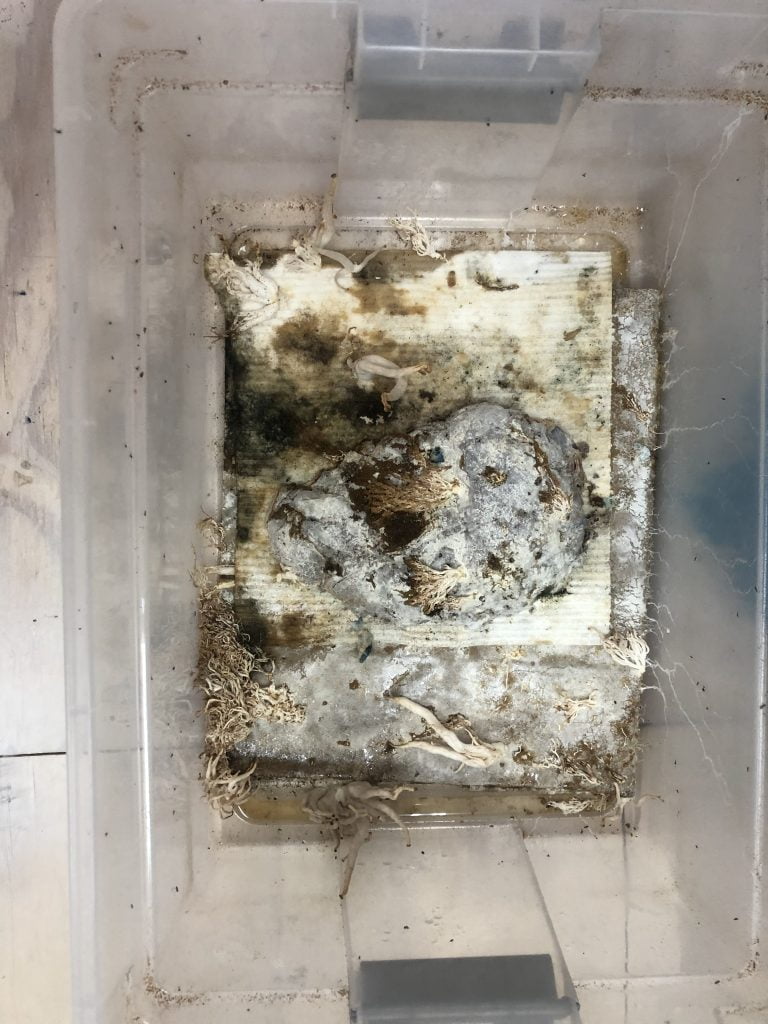
I had a revisit and earlier reading on the thinking behind the Verb List, called Richard Serra, Verb List Commentary (2004). A blog revealed the following: …….” I cannot overemphasize the need for play, for in play, you don’t extract yourself from your activity. To invent, I felt it necessary to make art practice of affirmative play or conceptual experimentation. The ambiguity of play and its transitional character provides suspension of belief whereby a shift in direction is possible when faced with a complexity you don’t understand. Free from scepticism, play relinquishes control. Play allows one to accept discontinuities and continuities; it also allows one to happen upon solutions or invent them. However, even in play, the task must be carried out with conviction. How we do what we do confers meaning on what we have done.”
How will I translate these actions related to myself, the material, place and process. I like to think along the lines that to be motivated to work/do/make; I need actions – these actions will drive the inspiration. For me, the research could be part, and the writing will become part of it. I like making lists whilst working and reading – words are part of my thinking/making. When I did another of my daily drawings, these words came to mind: I was wrapping wet plaster of Paris bandage around the object, folding it, moulding it, touching it, sculpting it. Thoughts of making and working with materials and how it reacts to my actions and hoping the outcome would be a mould that looks like the object. I made and worked with a medium to bring forth an object.
I am asking myself what the process of auditing my practice has revealed to me:
I do see threads running through my work – nature, living/non-living, ideas of presence and absence; that process is essential; words/language guide me are markings/tracing/tracks/lines, and I do feel there is a connection to looking, finding, searching, seeing, touching and responding woven within these connections. Honestly, I am more of a magpie and love randomly gathering things. I like keeping lists and writing notes, use sketchbooks to write in as well and would like to use ways of cataloguing my work.
My little Wundercabinet acts as my ‘magpie’ space, but this also spills over on some of my working stations and shelves. I see my organising materials as done by the degree of relevance and theme.
I thought it reasonable to share my desk, which on any given day might look like this:
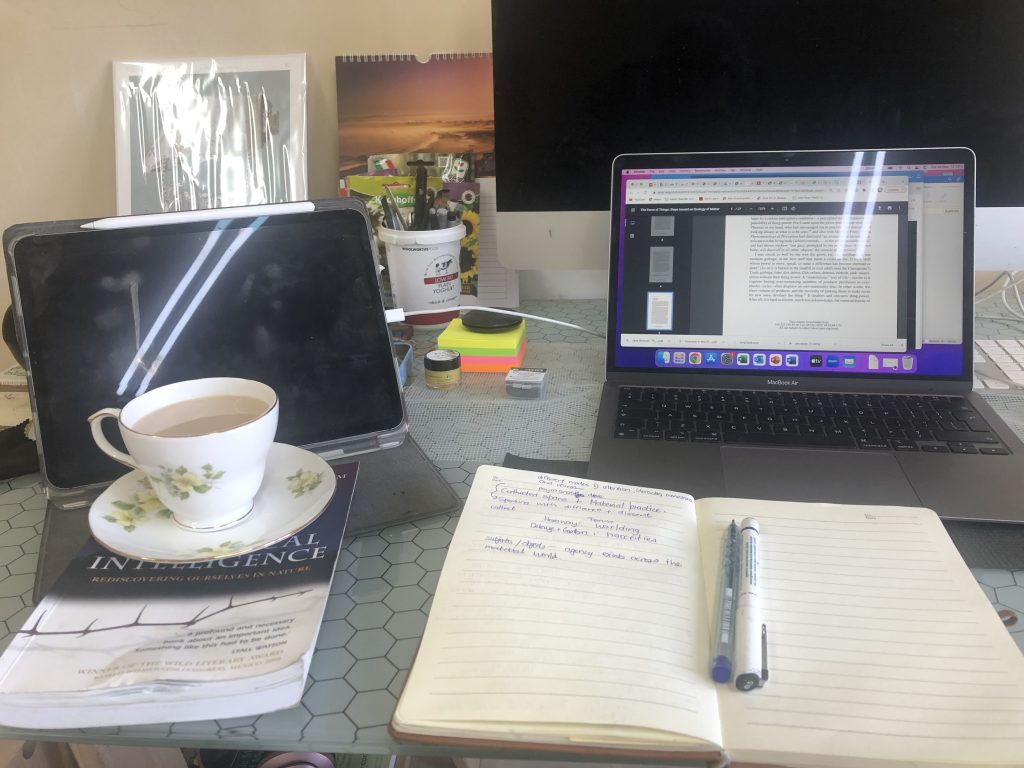
In the study material, the South African artist William Kentridge’s multidisciplinary art practice is discussed:
- ways in which the artist pays attention to a range of visual and other information; I think being so socially and politically connected to everyday society gave the artist insight and access. I particularly enjoy how he uses video projection, with drawings, to form the basis of animated films and succeed in retaining a more old-fashioned appearance. I enjoy in his work how he uses intentionality and chance: he makes marks and erases them. By doing this, he reveals how vision is constructed while encouraging the loss of oneself in the fiction he stages. I also think he stays experimental in his work.
- I think of artists in history like Goya and Hogarth.
In my daily practice, I started recently; I used one of his drawings as inspiration. The work, see image below, by Kentridge is called Sleeper Red and is a drypoint etching which is 97 x 193cm in size. I enjoy the messiness shown in the work and read that the artist wheeled a bicycle across the paper, had children and cats walk over it, and spattered it freely with pigments. His mark-making is intentional, and I became intrigued by the marks on the bark I have been drawing as part of a daily drawing commitment. This drawing was made on day 11 of drawing the same object as an instruction or score I set out for myself.
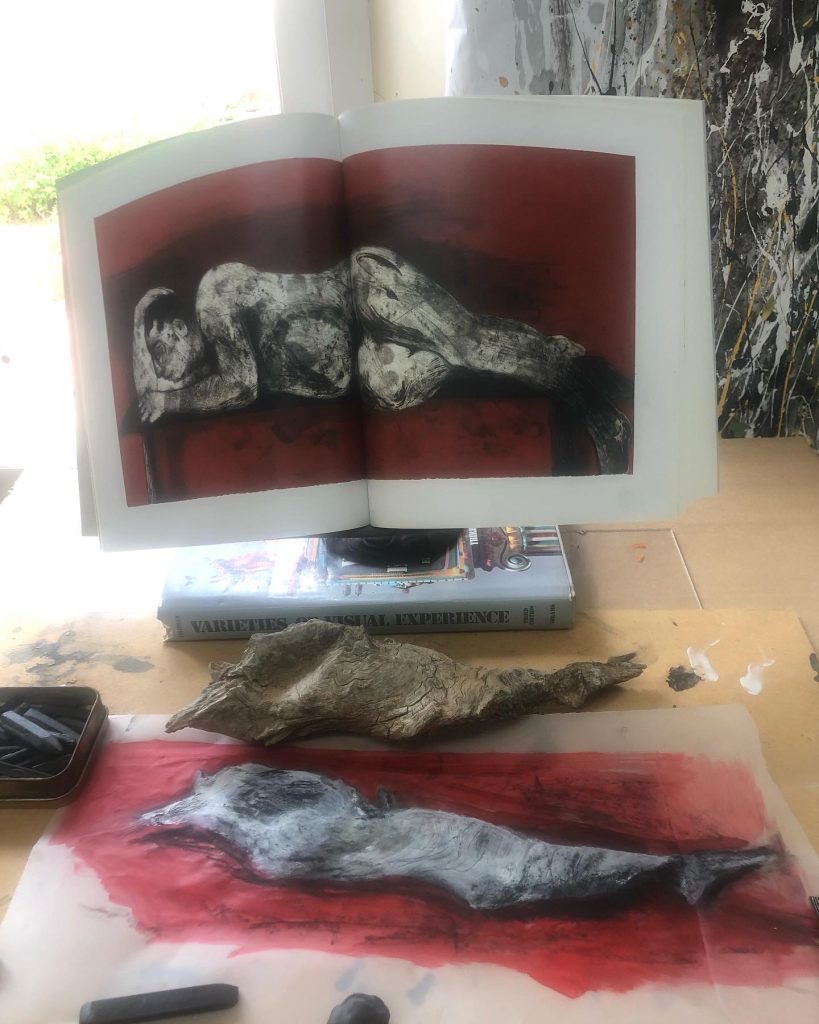
Exercise 1.1 Approaches to Research
Identify an artist whose work you feel encompasses an interesting research process. In your learning log, reflect on the methods, processes and practices employed. How do these help you to reflect on possibilities for your own research process? For example, you might consider ways in which the artist
absorbs or incorporates research into the practices of the studio, or involves others in the research process.
Xiaojing Yan
This artist makes sculptures using mycelium that eventually fruits into lingzhi mushrooms. (these are known by most of us in the West by the Japanese name, Reishi) The lingzhi is a bracket mushroom, meaning they create shelf or fan shapes when growing on trees or stumps. They are shiny and mostly burgundy, with cream-coloured edges when in their prime. Lingzhi is thought to promote health and longevity by boosting the immune system; some Taoists believe that God ingested them to achieve immortality.
Yan, trained in traditional Chinese painting, began working with mushrooms in 2014 while grieving the death of a loved one. Longevity was very much on her mind. In her first experiments, she cast lingzhi mushrooms in bronze, hoping to literalize the durability they symbolize in Chinese culture. But a few months later, she went mushroom picking back in China on a farm where lingzhi was cultivated. (She describes the activity as analogous to American apple picking in the fall.) Then, in 2015, impressed by the growing techniques she had seen at the site, she began creating sculptures using mycelium. After experimenting, she noticed she could form mycelium into controlled shapes by creating wood chip armatures that the fungus would engulf and eat. The resulting texture approximates that of papier-mâché. Yan began making moulds out of fibreglass and resin to control the profiles more precisely. The mushrooms grow in the moulds’ dark, damp interiors and eventually take their form: human figures and busts or animals like deer. A species skilled in mushroom foraging, deer enjoy even the psychedelic varieties.
A frequent motif is a bust depicting a fictive figure and is a mash-up of the artist herself and the many women from folklore. An interesting character in such a story is a female protagonist of the origin story The Mountain and the Sea: a young woman whose soul becomes a mushroom. Here it directs us to the mushroom as a symbol of immortality. Her works generally evoke the cultural significance of lingzhi. An Art News article described a visit to her studio, which I greatly appreciated.
” In a virtual studio visit, Yan described making the works akin to taking care of a baby: every morning, she gets up and checks on her sculptures. They are, after all, alive. Eventually, the mycelium starts fruiting burgundy brackets. Yan carefully controls the temperature and humidity, which affect the shape of the growing bodies. But still, only about half of the sculptures are fruit. The artist is intent on ceding some control to her fungal collaborators, though ultimately, she decides whether to compost the material or exhibit it. Describing herself as organized and methodical, she readily admits that it can be tricky to determine when to intervene and let nature run its course.
To prevent the forms that she deems artworks from decaying, Yan dries them out in an oven at a low temperature. Some release spores that coat parts of the sculpture with brown dust, making it look almost like tiramisu.” (Mushrooms as Metaphors, Emily Watlington, Dec 2021, published online in ArtNews.com)
I started using paper masks to make my first mushroom sculptures and worked with Oyster mushrooms spore, as that is what I had available and seemed to be able to grow in my medium and with the harvesting of spores. Below is an image which show how the mask was used to create a face into which mycelium could grow and eventually have mushrooms growing from it. It took less than a month till the mushrooms were ready for harvesting.
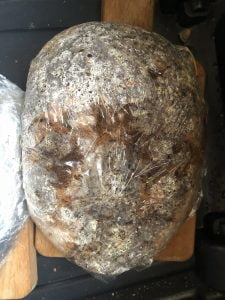
My medium started showing signs that I would hold if I took it out of the mask, which acted as the form. I used tinfoil to see if it would act as a holding for the medium inside the mask, which is made of paper and would become soft due to the moisture in the medium. Within two weeks, I could see the mycelium had grown entirely over one of the faces, and a week later, little mushrooms started to pin. The plastic cover was removed from the object, but it was very fragile and showed signs of cracks when I moved it into the growing box. It became clear that the medium I chose did not seem strong enough to stay firm. It could also be that it pinned too quickly because I cannot control this process very well in terms of temperature, darkness, and moisture levels. I decided to keep the other face much longer in the dark box – here, I could ensure to learn from the first mask that the mycelium needed to become tighter and firmer. I removed the tinfoil and kept the plastic layer over this mask as it was lying in the dark.
I took the second face out of the dark box and started making it moist to see if any pinning of mushrooms would show. It is much more complex and compact, but the first signs of pinning did not last – it could be that I did not keep this container (fruiting chamber) moist enough. I, however, decided to keep the object in this container and observe the progression. I did not implement a daily photographic recording of the work and almost forgot about it after I took a three-week break from my studies in November 2022. By now, there were signs of the mushrooms pinning, and I had to start caring for it. I have to spray it with water at least twice daily to keep it moist and ensure the new growths do not dry.
I looked at what I could learn from the artist Xiaojing Yan. It is essential to state that I used a different mushroom and that I am trying to get hold of the spore or culture of the Lingzhi mushroom. I will also work with woodchip – cellulose; I have now learned that the mycelium I made with paper is more compact than that of grind coffee and paper as a growing medium. To create the work asked that care be taken with the material: at the start, I had to work in a sterile environment to ensure spores grew effectively on the medium, kept it in the dark, and controlled the temperature and humidity as best I could. This meant daily tasks to check on it and adjust heat or moisture levels. In my situation, it meant moving it into different areas in my home and looking at the average temperature in that space. As soon as the mushrooms started to pin, I moved the object to a different box, where light became important for growing mushrooms. It seems place/space and time will play a significant role in my making and collaborating with the Fungal Kingdom. I must remember working with a living organism and consider care and maintenance. This should lead to reading about feminist theory as part of my practice and research.
I noticed how spores were dropping on the paper surface of the face, and by Monday, 3 October 2022, I decided to let go of the face and the paper covered with spores to decompose with another ongoing project. (blog in Part One of Advanced Practice). The second face is now being cared for, and I keep documenting the daily development.
With regards to mushroom growing, I also have Ideas around sensorial connections: touch, see, hear are also part of the questions I would like to address in my research. Only recently, I came upon the work of Melia Roger, and looked into her recent work called, In tangible otherness, toward eco emphatic listening.
With microphones attached to her hands and listening to the amplified touch through the headphones, the artist explores hidden layers of the landscape. Inspired by the notion of “in-between” developed by sound artist and researcher Salomé Voegelin, the sonic textures created with these concept highlight relations usually existing in void and silence, without any touch. The point of connection, first thought of as sonic friction can be explored with care and tenderness, questioning the consent of others. Trying to shift away from an anthropocentric listening position, the artist offers the term ‘eco-empathic listening’ to address the act of carefully listening to non-human and more-than-human beings: she strokes the surfaces of rocks, lichens, barks and skin with delicacy and care.
Believing that listening to the environment can inspire ecological change when the public develops an emotional connection with an artwork, the program offers a workshop on July 2nd. During the workshop, the artist invites the audience to wear the “sonic device for eco-empathic listening”, a self-developed device of headphones and microphones attached to the hands of the wearer. The device makes it possible to explore the sound textures and surfaces of the environment through touch and attentive listening. The audience’s insights are recorded to create a collaborative work highlighting the complexities of our intricate and deranged relationships with the environment.
In earlier research, during SP, I came upon the work of experimental composer John Cage, who was also a dedicated amateur mycologist; during that time, I did a workshop with OCA students and the music programme leader at OCA, dr Carla Rees. I became interested to use and experiment with sound in my work.
I have now looked at devices I could consider using; the technology is called biodata sonification, which means using technology to turn the bio-rhythms of natural objects into sound. Creating sounds and using synthesizers to give your plants a voice can become a complex process.
“Biodata Sonification is the process of extracting real-time biological information from living plants and translating that complex information into sounds which a guest can perceive.” (Sam Cusumano)
One device I read about is called a MIDI Sprout: electrodes can be attached to plants, and it will pick up fluctuations in galvanic conductance on the surface it is touching. By using this device, I need not look at buying a synthesizer. The sound App of MIDI will do the output of the sound. For me, the value lies in the information from the plant becoming sound.
These fluctuations are then translated to MIDI with this Sprout, and the signal goes to a sequencer. I ask myself about the importance of using these machine interfaces to understand the real world – I think it is about engaging with people and creating more significant awareness of the other. I found Sam Cusumano during my research into biodata sonification. He describes himself as an educator and an Engineer for the Arts who uses electronic components and sounds to lead workshops, classes, and performances which explore human interactivity (and attempt to represent complex electrical and biological processes using circuits and sound).
Cusumano wrote a musical piece performed by the plants of the Wildflower Botanical garden at the Philadelphia Flower Show in 2019. It is called The Sun Stand Still and was made by using sensors to track the changing biological states of the plants over 35 days through the Winter Solstice (November 25th – December 31st).
I learned from anthropologist Tim Ingold that ‘umwelt’ is not a fixed sensorial idea or tangible category but an active process of making by different species. To me, it is about sensing (becoming aware of) this engagement – a continual process of forming relationships. I am reminded of something I read at the beginning of SP when an exercise asked me to use a map/diagram to reflect on the making processes. Ingold (2007:84) views maps drawn by humans as a gestural -re-enactment through lines of movement of journeys made. I am thinking of walking in nature and collecting or looking at fungi, and ask myself if that can be seen as an embodied performance. Am I ‘reading’ something about nature when I interact with mushrooms?
Thinking literally and metaphorically – alchemical.
List of Illustrations
Fig. 1 Stander, K. (2022) Growing [Photograph of living mushrooms in a container as a WIP] In possession of: the author: Langvlei Farm, Riebeeck West.
Fig. 2 Stander, K. (2022) My writing and research desk on a given day. [Photograph] In possession of: the author: Langvlei Farm, Riebeeck West.
Fig. 3 Stander, K. (2022) Drawing inspired by a Kentridge print. [Photograph] In possession of: the author: Langvlei Farm, Riebeeck West.
FIg. 4 Stander, K. (2022) Mycelium Mask [Photograph] In possession of: the author: Langvlei Farm, Riebeeck West.
Exercise 1.2: Flow of consciousness – approaching new challenges
Looking at a SCOR diagram I started making my list of strengths and opportunities when I look at starting something new. Words that came to mind was: I think I can give it a try, I like this/or that, I should consider how it fits with current ideas, where did it come from.., exciting, challenge, can I? what will I learn, do I have time, How do I start? Does it relate to my questions, can I do this as well..
I do like the stimulation a new task or challenge asks. I can be over excited and loose track of time it asks of me. I am motivated to search for new understanding/learning I need to keep to a plan, keep a schedule or manage time better.
https://spectrum.library.concordia.ca/id/eprint/981054/1/Re_MA_S2016.pdf
Exercise 1.3: Mind Mapping
I looked at the work mentioned in the study material ( Mind map by Caroline Wright and Helen Rousseau). I learned that this is an ongoing research project which started in 2007(not sure if it is still going as it was funded and the funding came to an end) and looked at the potential of the relationship between drawing and writing. It resulted in a body of work which included drawing, animation, sound and video work with poetry and text. I found it exciting that Phyllida Barlow was the other collaborator, as I appreciate and aspire to her use of materiality and the objects she creates. I am not familiar with the poet, but I read some of the work I found on the website of Caroline Wright (my current tutor for Advanced Practice and head of OCA Fine Arts).
I learned that these artists use drawing as a fundamental tool in their practice. As I read this, I realised how making is seen as enquiry and that artists can (should) have conversations around their processes and outcomes. In this case, it was through postal and virtual space exchanges. I see their discussion and body of work created as research and enquiry – a process that could be kept alive as long as the participant feels or wants it to continue. It could be responding to writing in visual form, written, and so on. It also confirms that writing is only a form of enquiry; art and its methods are also. It also allows the work to become published or shared during discussions or on a blog post or exhibition.
I am part of a student group, and within this group, 4 of us have started a crit group – we use the WhatsApp chat to respond to each other’s work and discuss or artists or reading we have done and how it impacts our work. I will look at our communication string as a form of mind-mapping, as I have benefitted from these interactions in developing ideas or bringing in new ideas. One suggestion, which led to my daily drawing commitment, was to start with a 15 min making of something, it does not even have to relate to current projects. We looked at Bruce Mau and the rules he set out, he called it an Incomplete Manifesto for Growth, which according to him, would be a way to sustain a creative life or lifelong practice. This manifest consists of a list of 43 statements that one can implement. If I think in the context of research, no. 3: Process is more important than the outcome; it connects with research to me, as he writes:”..if process drives outcome, we may not know where we’re going, but we will know we want to be there.”
One of the textile students wanted to develop her drawing skills, and we looked at work I found on IG by the surrealist artist Hedda Stern. I mainly found her earlier practice interesting: Her paintings from 1967 were created by pouring thinned acrylic paint onto raw canvas. She embraced the element of chance and then returned to the canvases to reinterpret and draw out the forms by adding lines or swathes of overpainting. She likened the forms that emerged to the dense folds of lettuce leaves, which for Stern became metaphors for growth and metamorphosis. In my explorations below, I worked with mushroom ink and pigment powders. I realised that the work reminded me of bark cloths I collected years ago – it was interesting that this also came from one our my ‘crit group’ members, and another felt it reminded her of Maori work. I learned that I could work with other natural pigments, like chestnut hulls or walnut, but this is not easily found here in SA. I do like the idea the the work developed organically and that I did not plan the design – I would like to make at least two more and consider using them as a collage or frame together. I will explore how the African Bark cloth is connected and appropriate in my work. By now, I would like to use mushroom ink in all the attempts of the envisioned cloth and see if I could then put it in a moist and dark place to see if mycelium would grow.
New ideas for material:
- I have Raw Umber Pigment from the Schmincke brand and will make another attempt.
- I can use the pigment of lichen I have collected at the coast recently
- I would like to try to work with tree bark
- I enjoy making marks with thread stitches
- I could work with natural type thread – like plant based string…
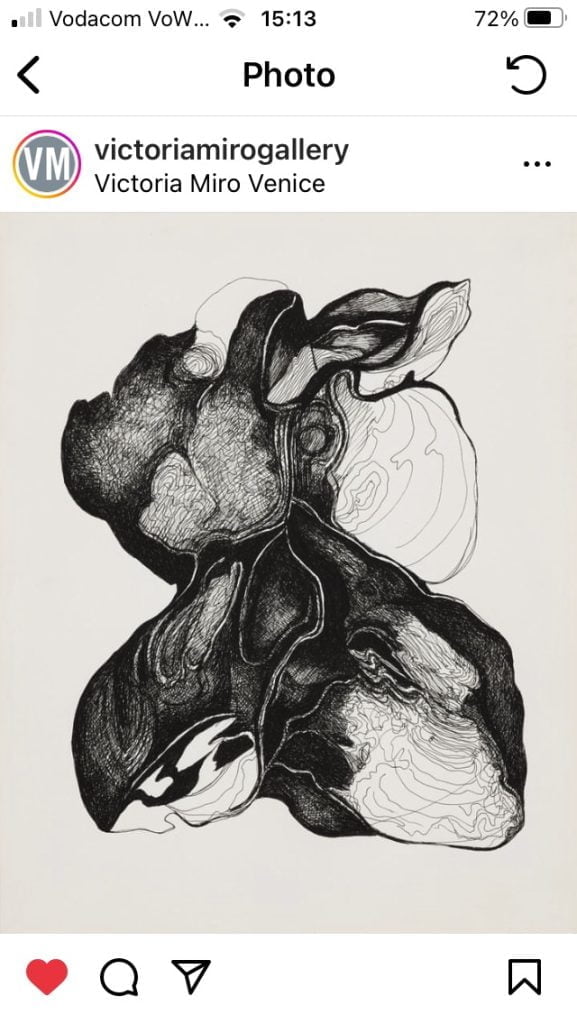
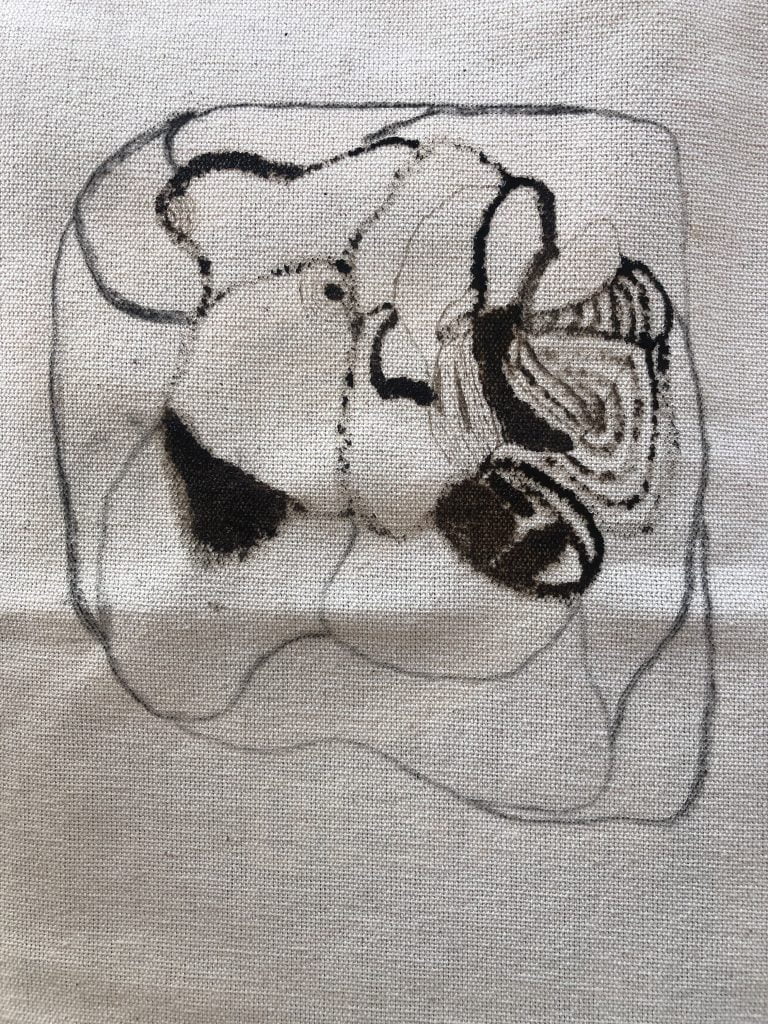
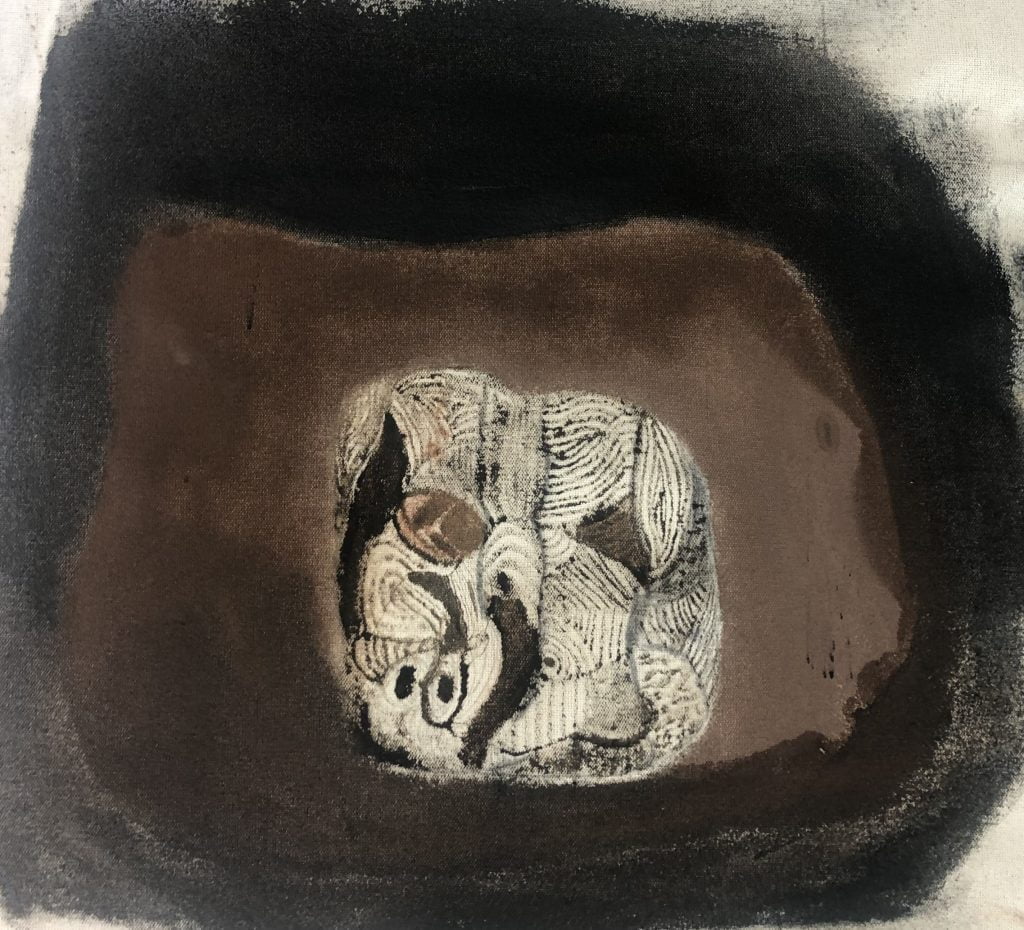
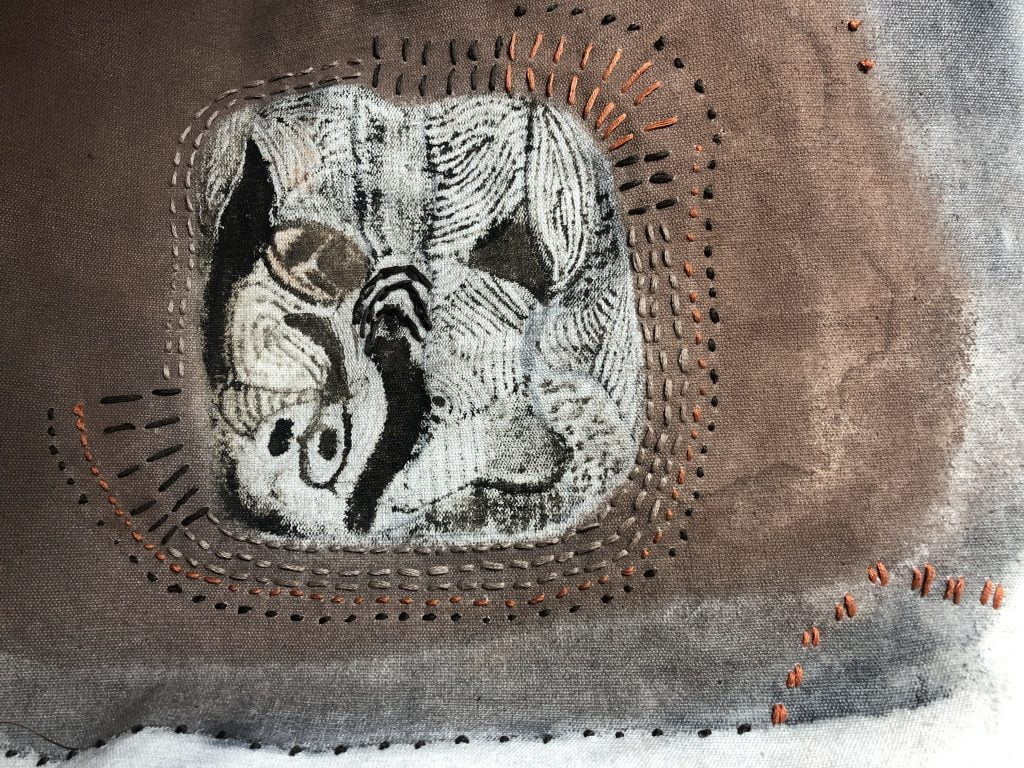
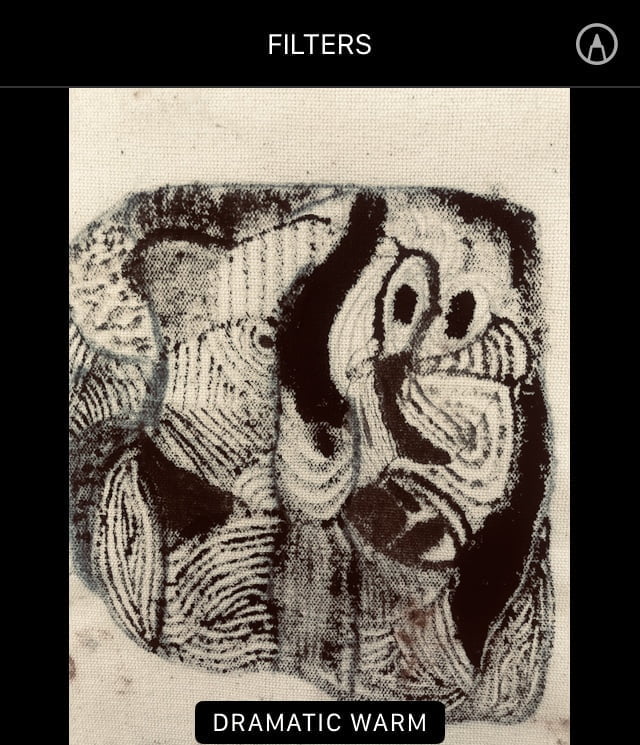
IMFG
Early stages of the work in progress can be seen at www.respondreply.blogspot.com
Exercise 1.4: Concept Mapping
My google search gave a clue to concept mapping: A concept map is a visual representation of what you know about a topic. Concept maps help you organize your thoughts and explore the relationships in a topic. Use a concept map to organize and represent what you know about a topic. Explore the connections between elements of the topic
I must remind myself that it should be an in-depth exploration of a particular idea. Firstly I thought about Spore Prints:
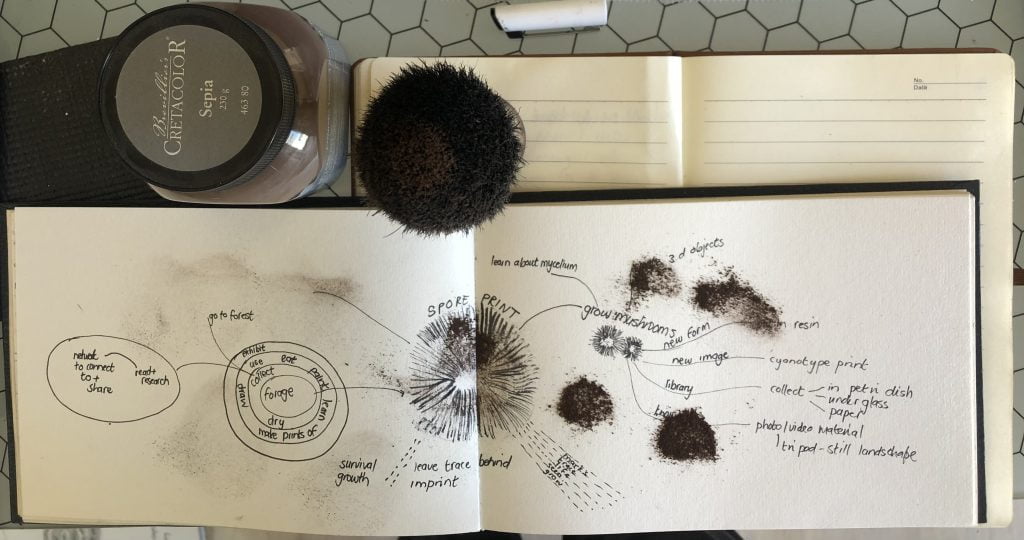
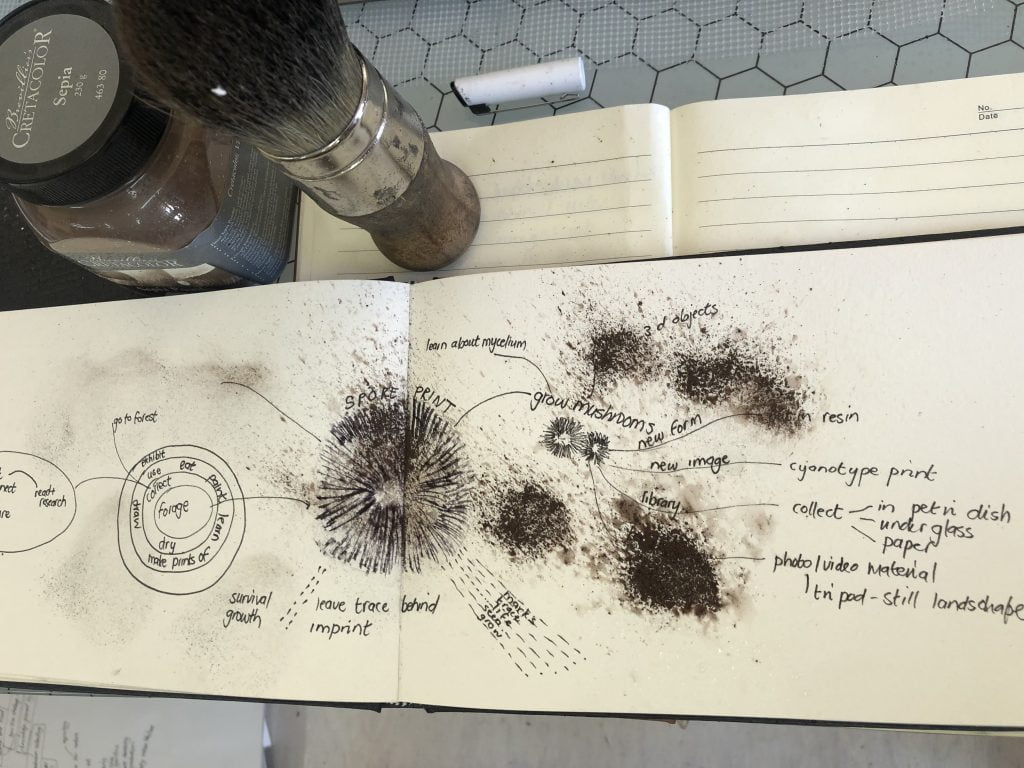
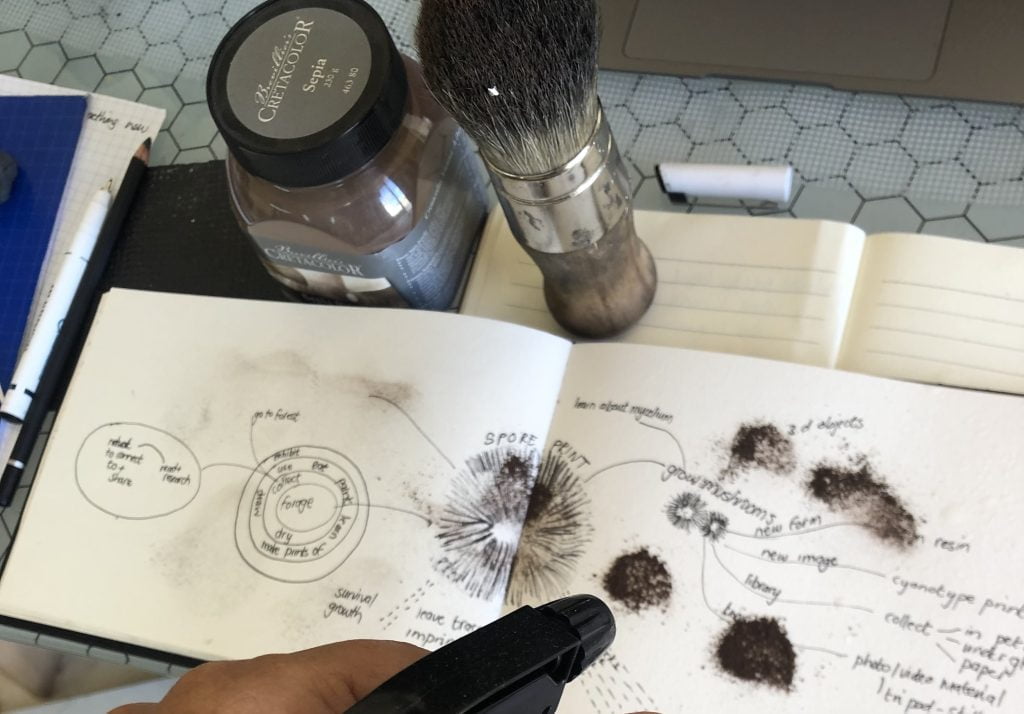
I do like the idea of finding entanglements within my research. I feel my work with fungi is very much a narrative about a network above and underground. The underground network of mycelium is fascinating regarding how fungi grow and support other organisms and living material for their intra-connected and beneficial relationships. Here one can think not only about the fungi but all other living organisms and plants which has roots in the ground or live within these roots or tunnels underground. I continue the map by layering it with more drawings, collages on a found netlike fabric (vegetable bag).
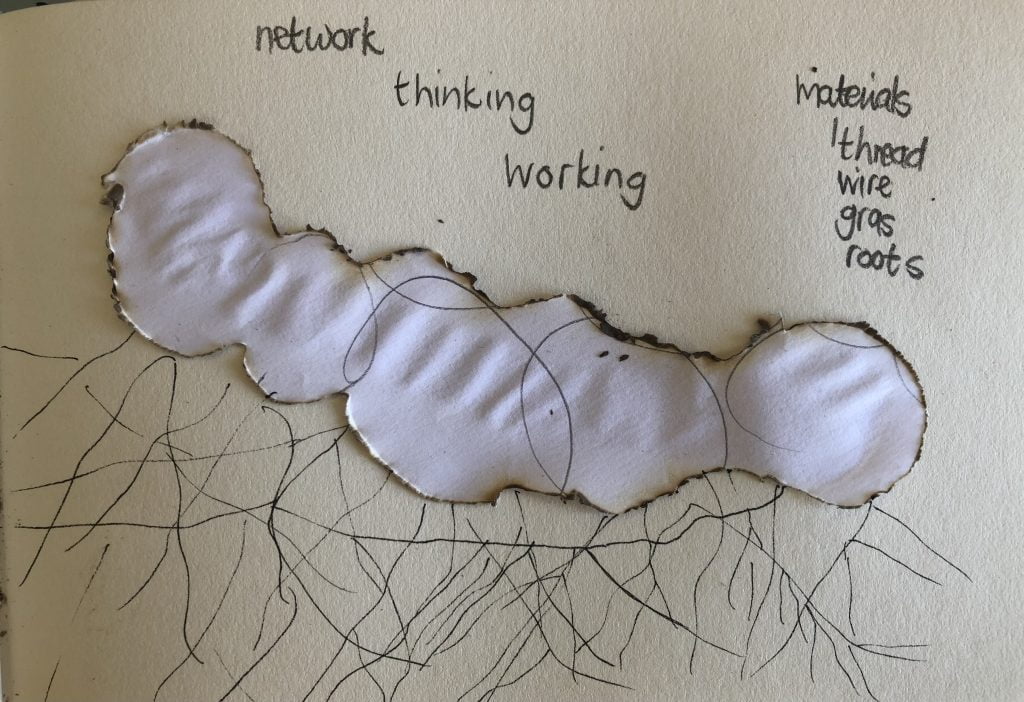
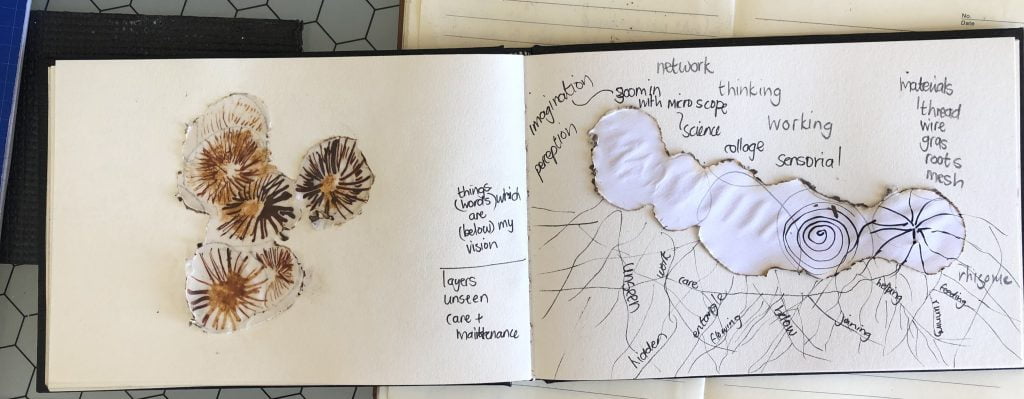
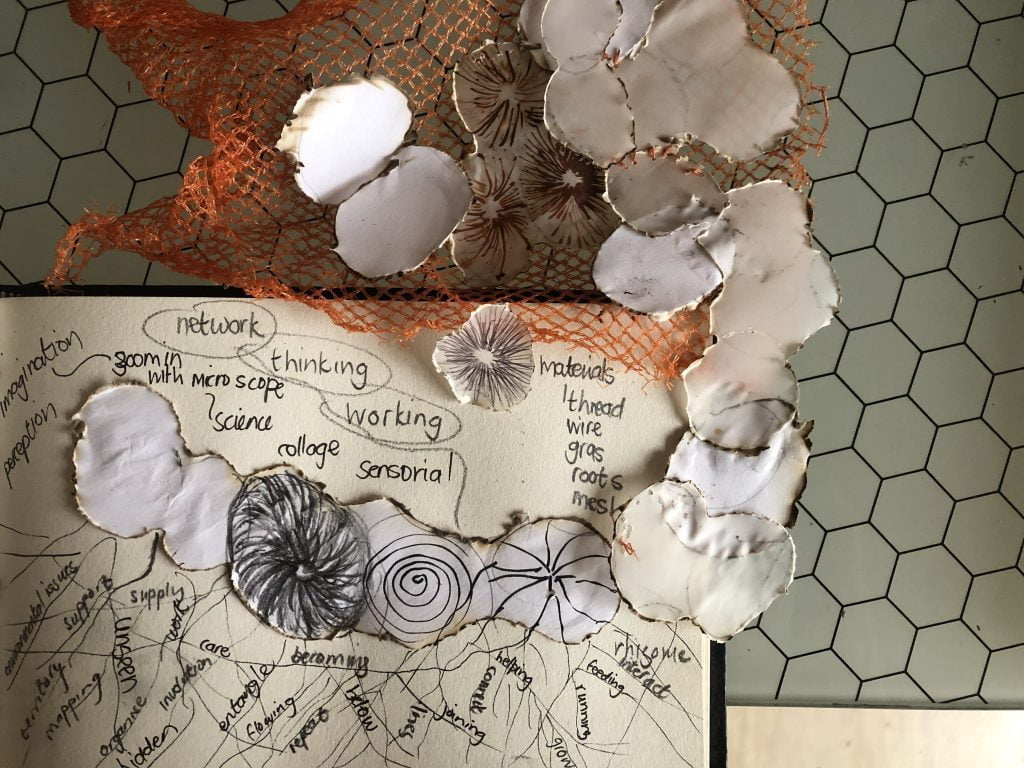
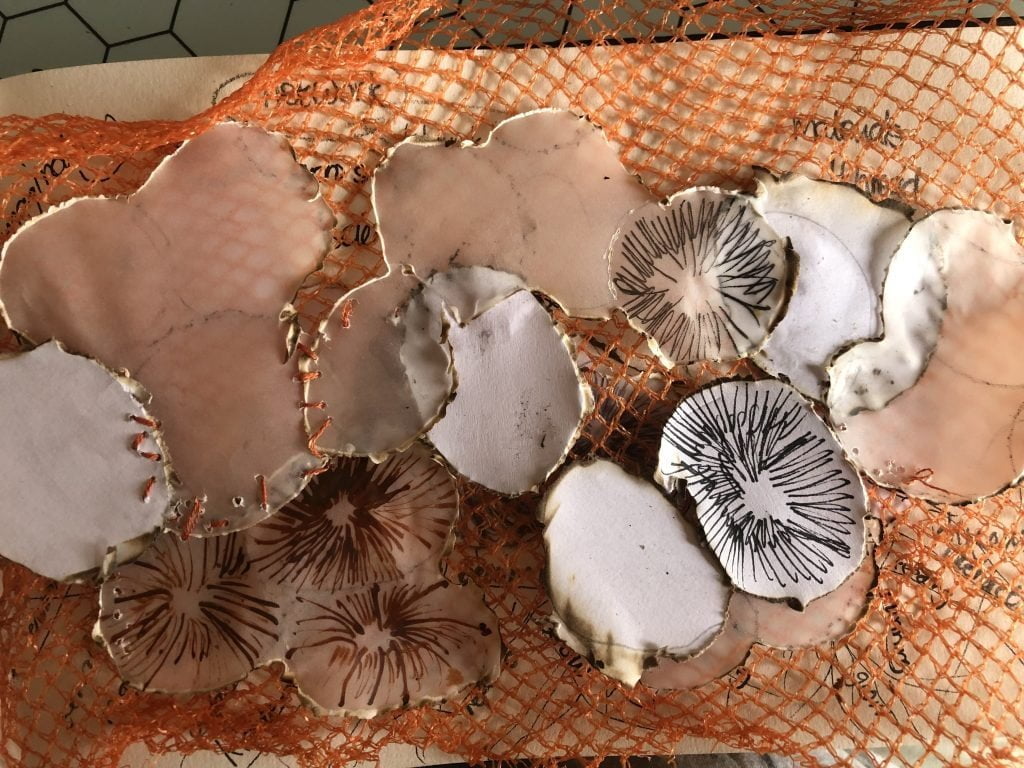
Exercise 1.5: Developing ideas
I want to share a learning experience I had during a recent cyano print workshop I attended. My most significant learning was solving how to use fungi spores in printing. Up to now, my attempts have not been successful. I learnt that I could take photographs of my spore print collection and convert them to negatives onto film or acetate sheets (Inkjet Screen Printing Film) and then do the cyanotype prints with this. I learned that there are programs, like Photoshop or even cell phones, that convert to negative images. I must ensure the printer I use can print on acetate paper/film. The idea is to have the light areas of the image become dark and the dark regions of the images become light.
Here are prints I made at the workshop, using the photo negatives of the artist who presented the course:
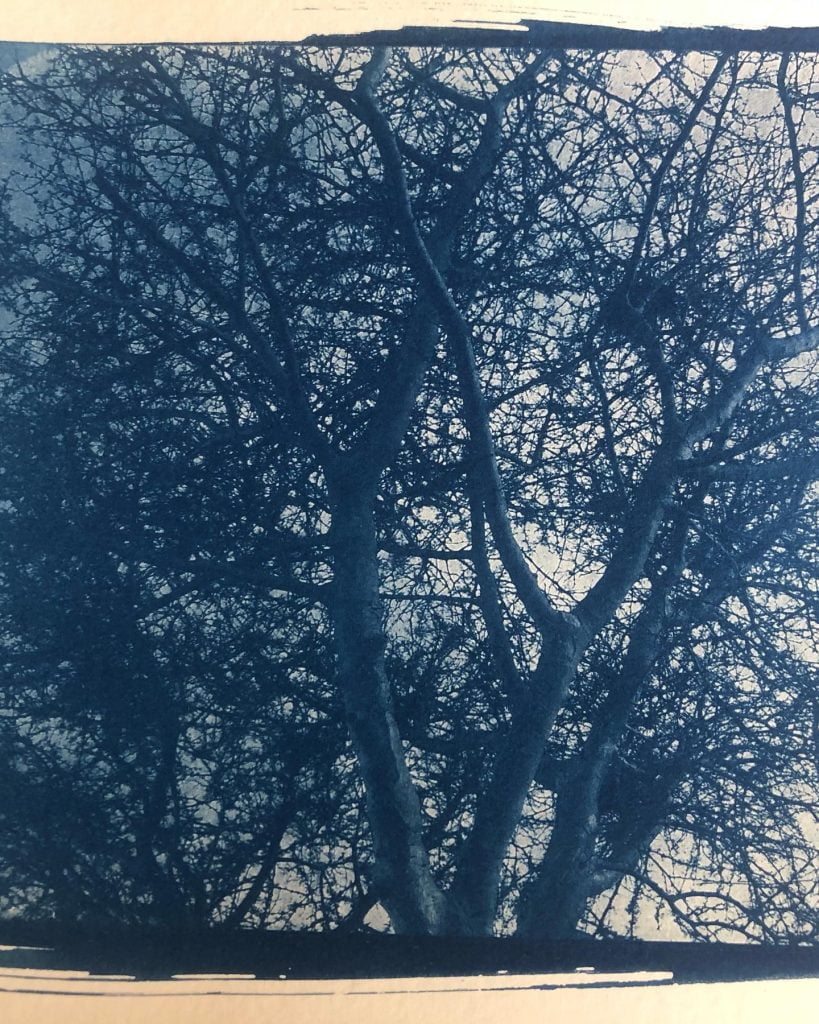
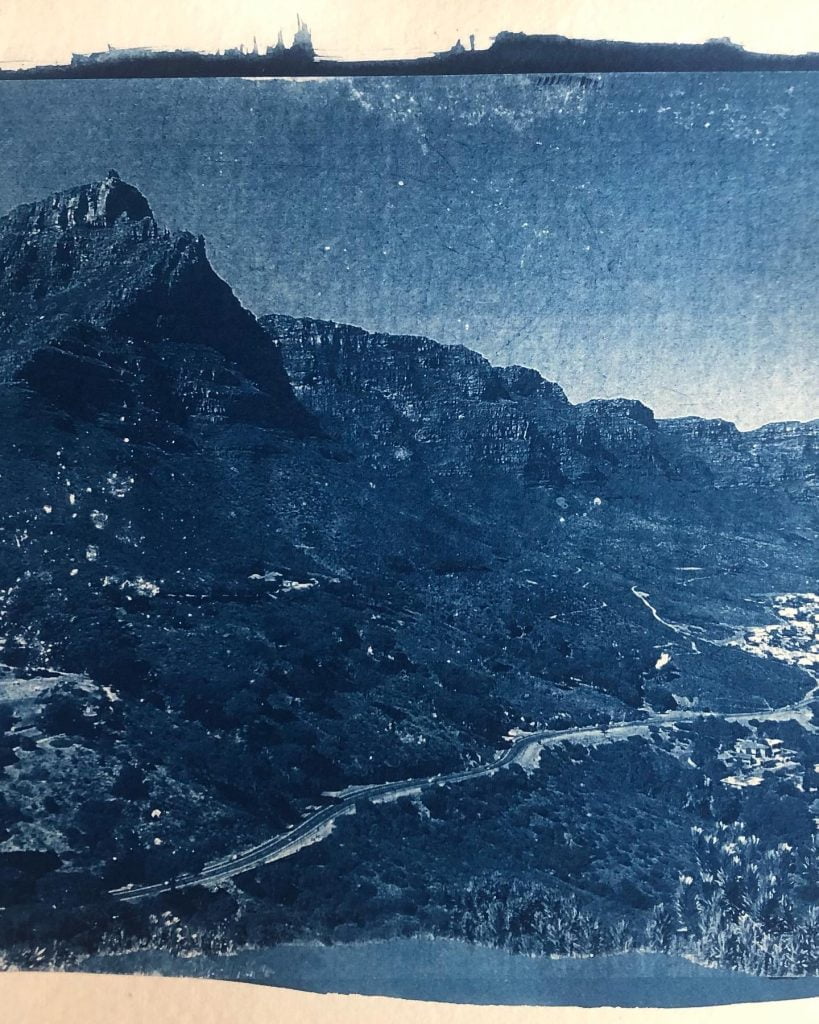
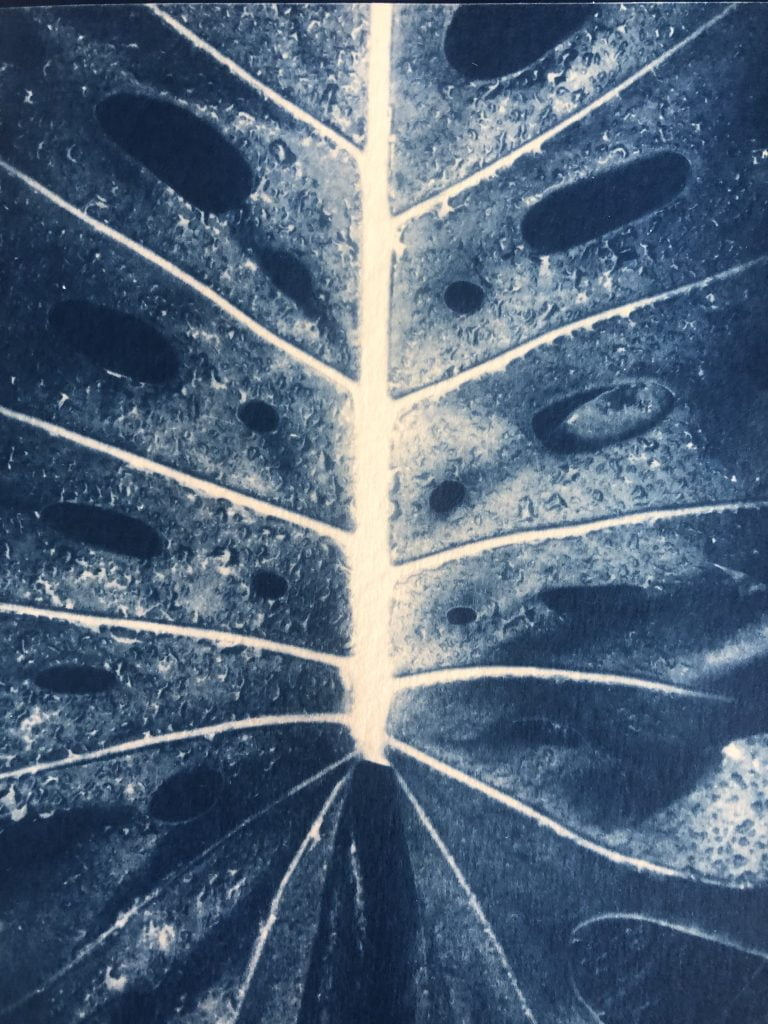
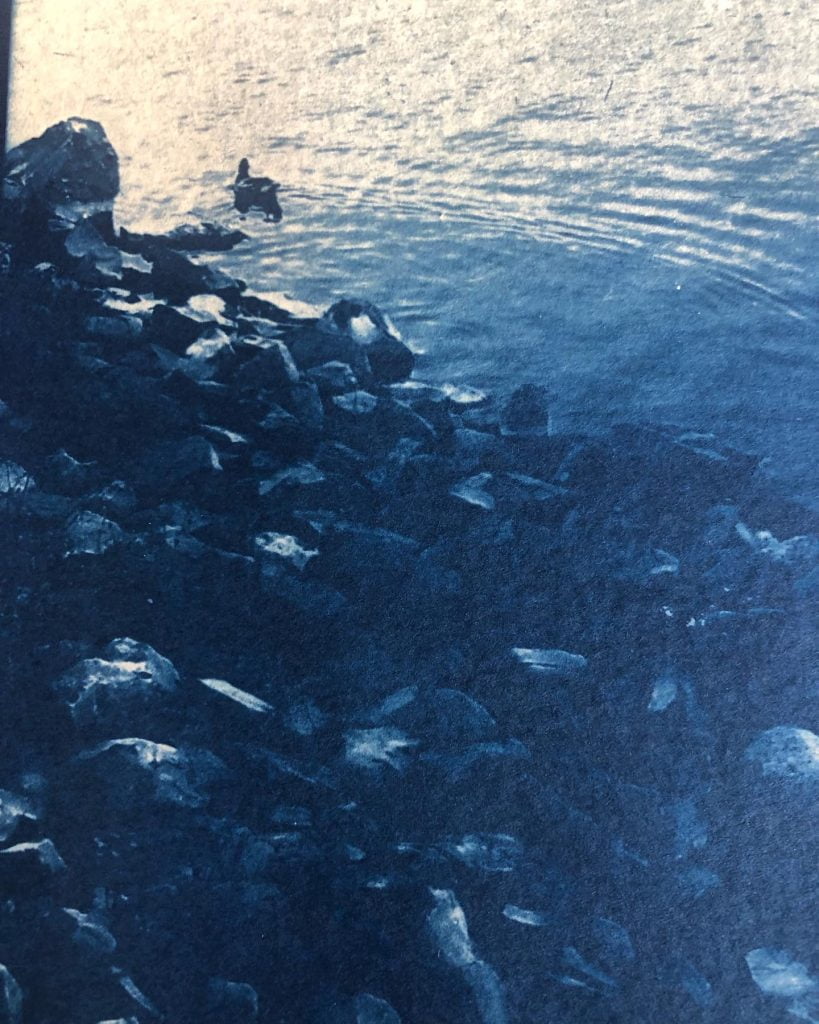
Key aspects that stood out:
I can say that I now understand that I should add my walking as an element that has creative potential – when I forage for mushrooms, I am also walking, and my senses are open to what I hear, feel, see, experience, touch, and do.
Apps to use to make negatives. https://photoworks.net/how-to-make-a-photo-negative.php
Exercise 1.6: Mapping sources
Books:
- Natalie Loveless: Sensing the Anthropocene
- David Abraham: The Spell of the Sensuous
- Jane Bennet: The Force of Things
- Merlin Sheldrake: Entangled Life
- Maria Puig de la Bellacasa: Matters of Care: Speculative Ethics in More than Human Worlds,
Literature or music – read or played alongside.
Site of an ongoing project of Involution, the collaborative project I started with OCA textile student Annette Holtkamp will continue. It is summer here, and I am not sure the conditions will create a living work for the next few months. I keep it under the frame but not in the dark any longer. I do wet it from time to time, as the weather has been hot and windy recently. I have seen short bursts of fungi, but mainly it dries out during the warm days. I visit the site regularly; it is outside my studio. I had a wonderful encouragement after a recent visit when I found mushrooms had started to pin, and outside, almost under the frame in one of the corners, a big cluster of oyster mushrooms was growing. I feel encouraged by this development, my actions have shown results, and I was completely taken by how nature has played along. We had soft rain and moderate to humid weather conditions during this period.
Photography, printing, add cyano printing walking as an aesthetic practice (foraging, being in nature, found objects, deep listening, connecting….). Consider using blue and yellow as colours in the practice, primarily monochrome.
I was also contemplating the use of a conceptual collage: I do like the idea of using find objects/images/artefacts to create a type of mood board and think this idea is pleasing to create.
The work below was started as a drawing with pastels, and I added the found mushrooms on top. I see this as exploring cyanotype printing; the blue colours were inspiring. I have picked some mushrooms in the garden and wanted to layer the work with them. I made a separate spore print work, and added a freshly picked mushroom to an older spore print work.
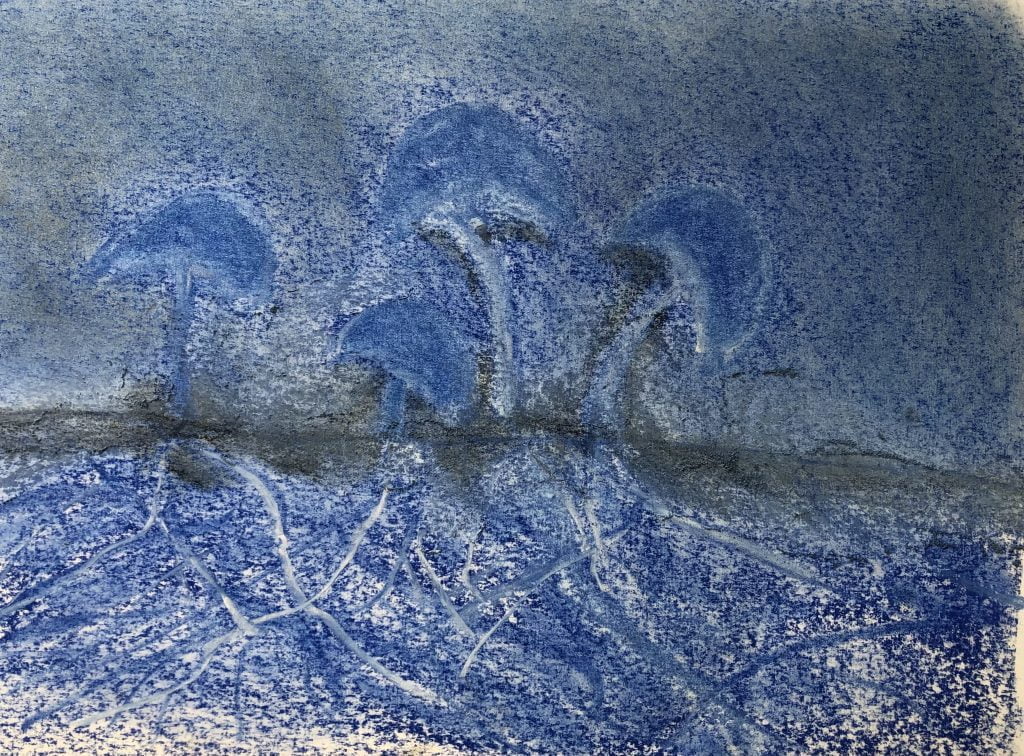
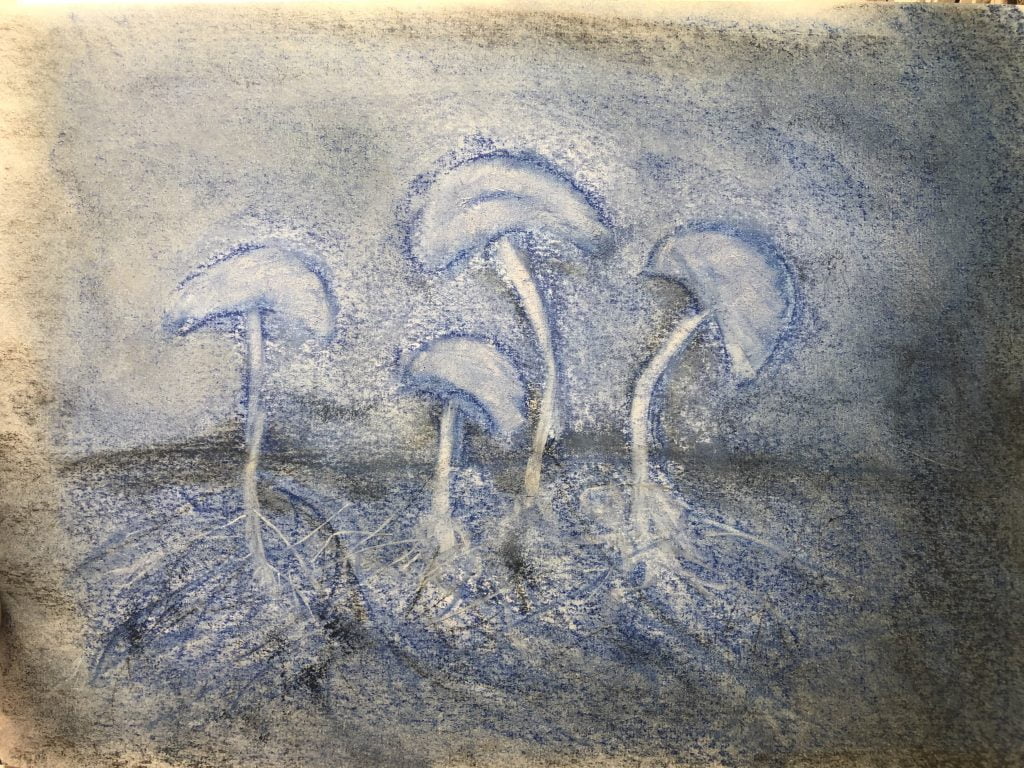
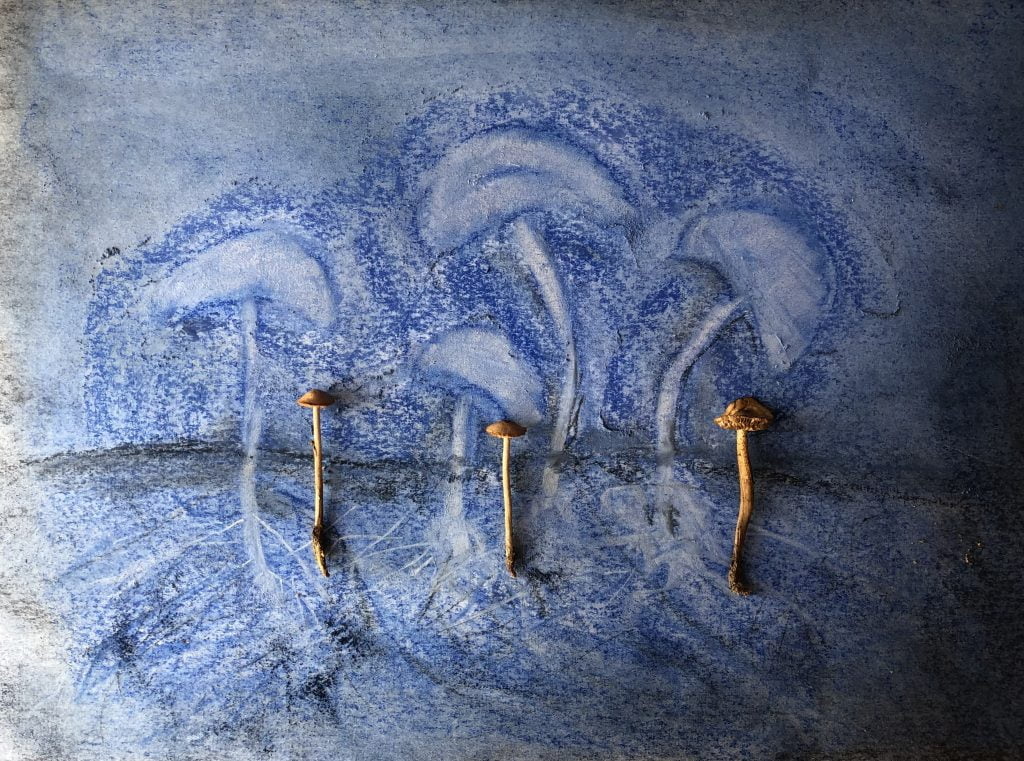
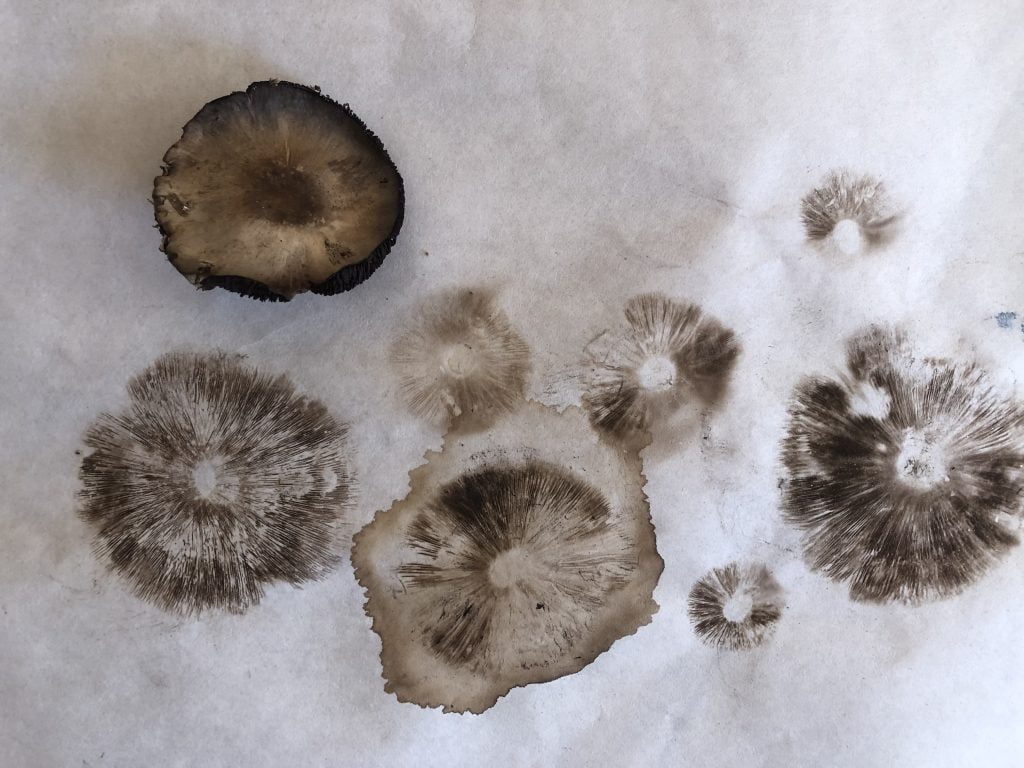
I continued using a phone app for photo images and layered the works. This is now digital work, reminding me of cyano print and foraging.
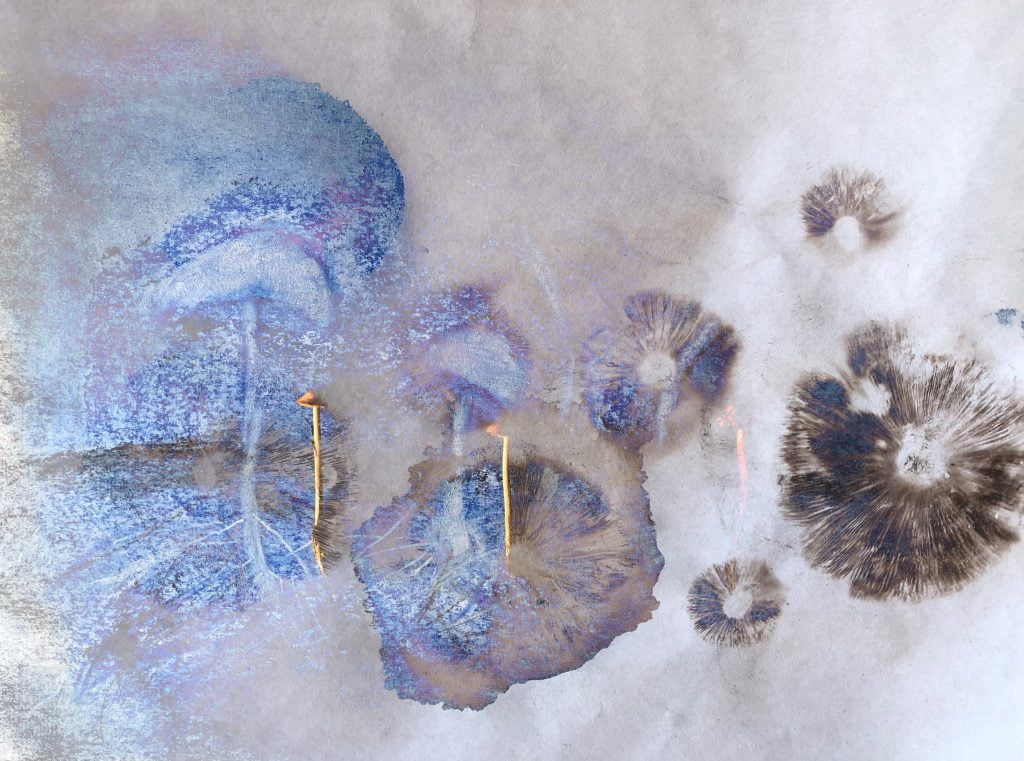
I continued with the idea of using the digital image. I could look at other enhancements, which led to the understanding that I could make negatives, print them onto acetate or jet print film, and use them for cyanotype prints.
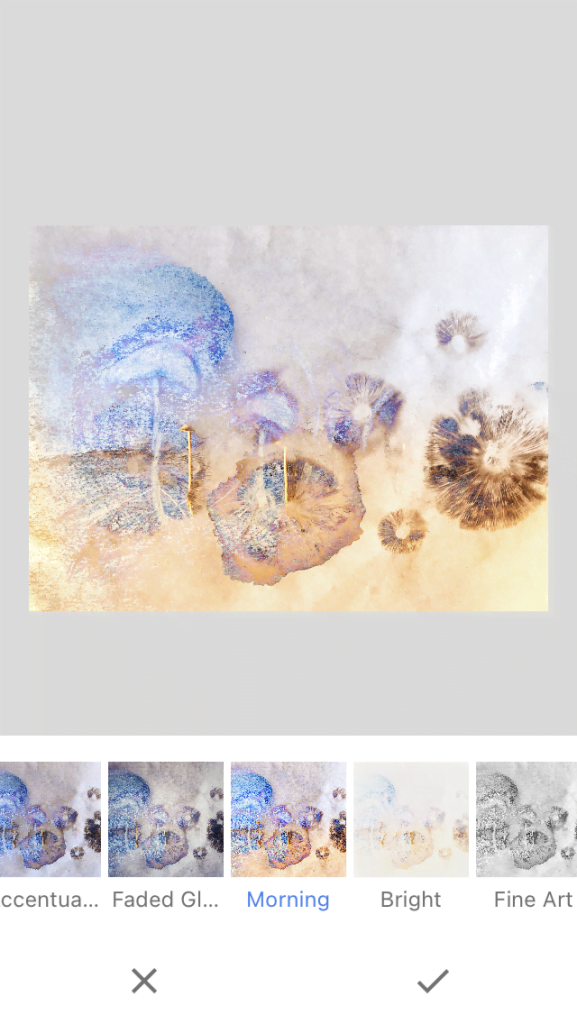
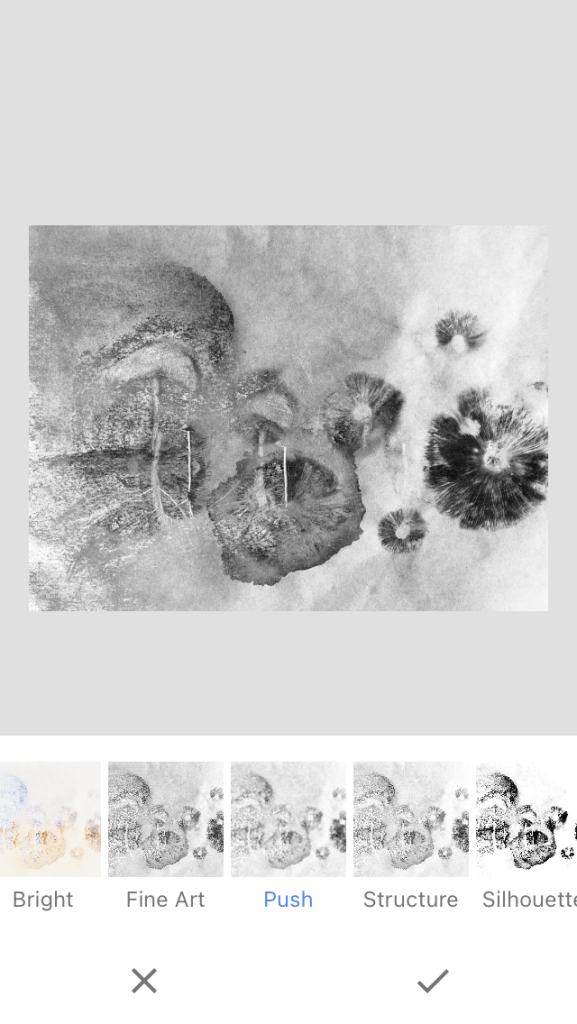
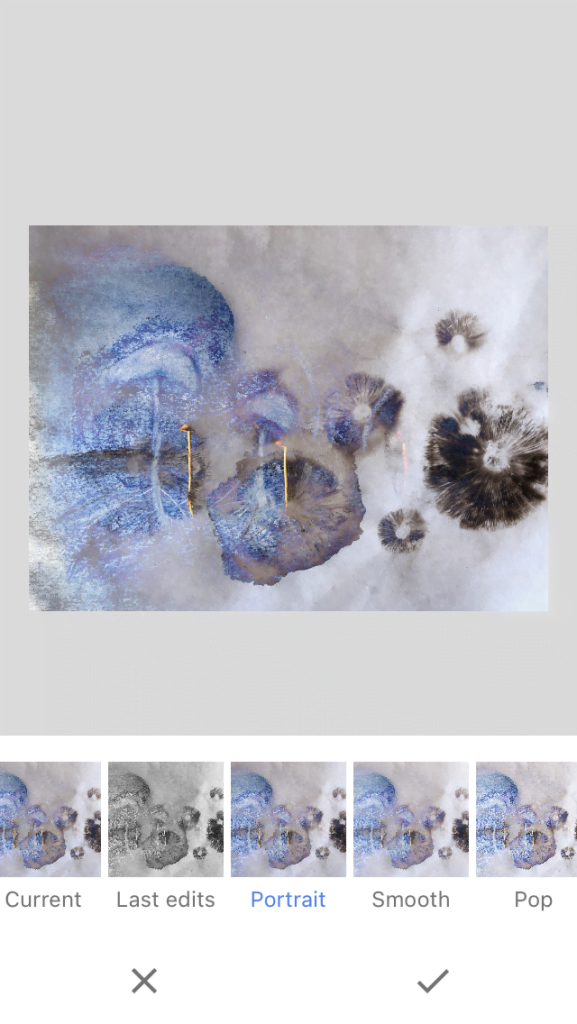
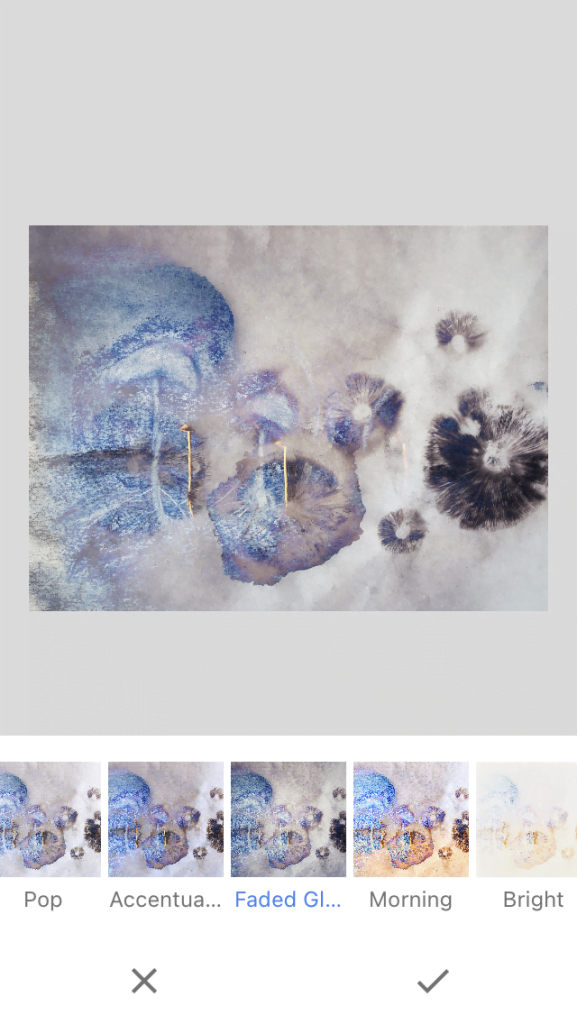
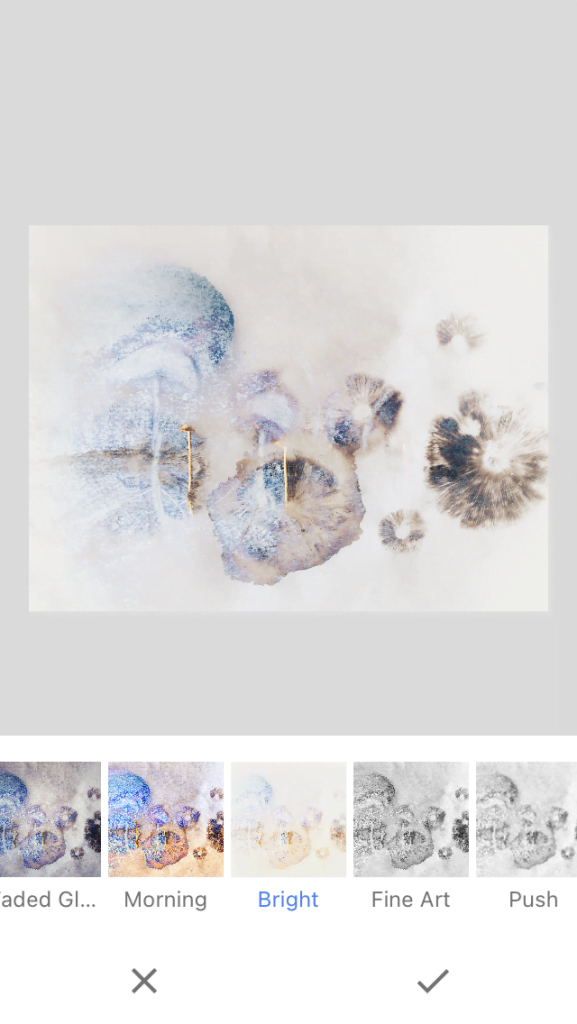
I have started lists made up of words I use in my practice that have meaning and could be used or to be researched.
Exercise 1.7: Artists and Words
My idea of my Body of Work and how I would like it to be exhibited could go with instructions, as I am thinking of different areas where living mushrooms would become part of the exhibition. Light, humidity and water supply would be essential in the spaces they have to exist, and there would be instructions on these conditions and technical support suggestions. Drawings/paintings and video, and photographic material should tell a story of foraging and show how mycelium grows and fruit. I would like to see a section which functions like a laboratory and a section for exploring and physical connection – such as soundscapes and seeing different stages from pinning to flowering mushrooms. A separate area could cover lichen, pigments and mushroom ink work.
I decided to use an instruction piece to challenge my drawing practice. I consciously chose to challenge my daily work/making alongside my studies. The Fluxus movement I had collected a piece of wood after a walk and decided to make a public commitment on my social media accounts (Instagram and Facebook) that I would be drawing the same object for 30 days. I did not put rules about the length of time I would spend on each effort, but decided it should be the first making of every day in my studio. I had a keen liking for the object, and the exciting shapes on it had the potential to inspire ways of working. My experience became that of enjoying a focused making process, not considering too much about the following work, not correcting or reworking or overthinking the making, embracing mistakes and enjoying the process of looking and reacting by making a work which could, in a way become a repetitive task of taking care of something I enjoy. Ready here, I show my interest in experimenting with new ideas and use playfulness to explore and find ideas. I am open to handling my judgment and fears about publicly sharing my work. I believe in action, which comes before motivation, and inspiration would be vital during this process. I also experienced in drawing that my senses and thoughts are open and that I am very much in that moment. I have been experiencing a difference in my studies – I felt I was going all over the place with too many things and ideas happening around and inside me. The drawing time became a particular time to do and not overthink.
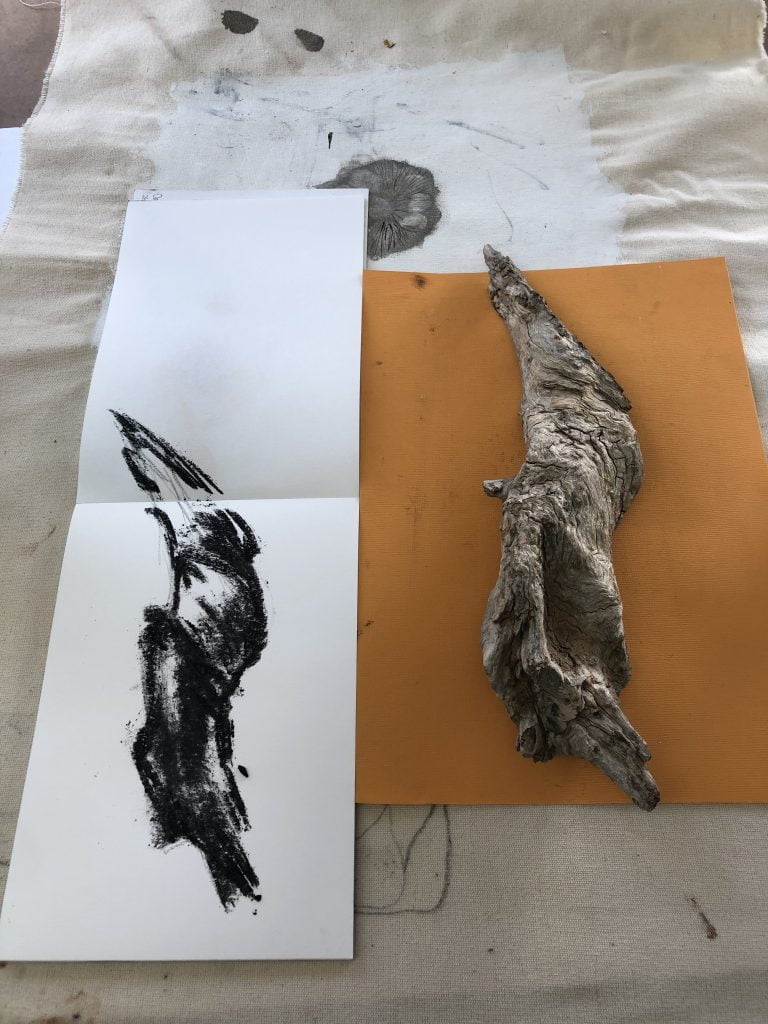
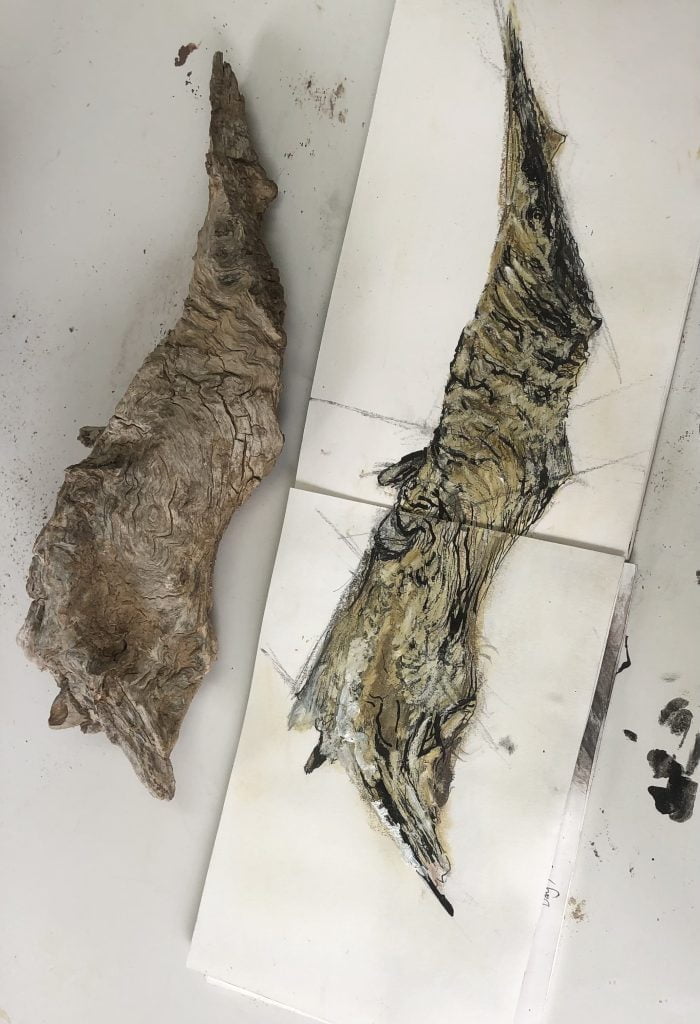
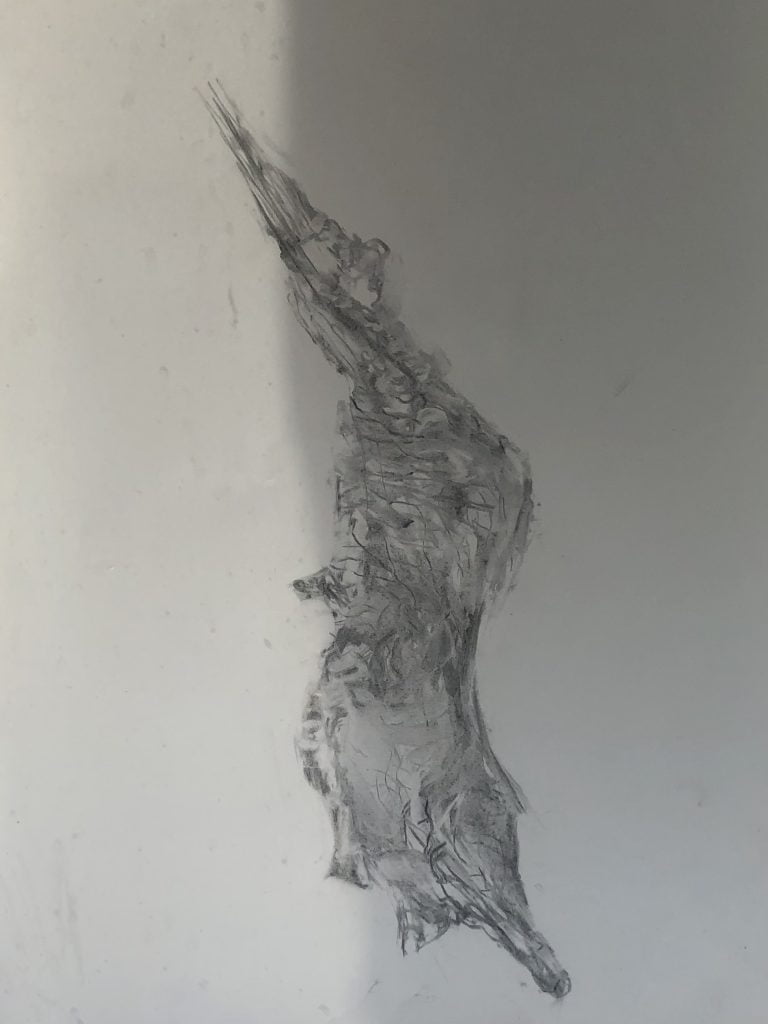
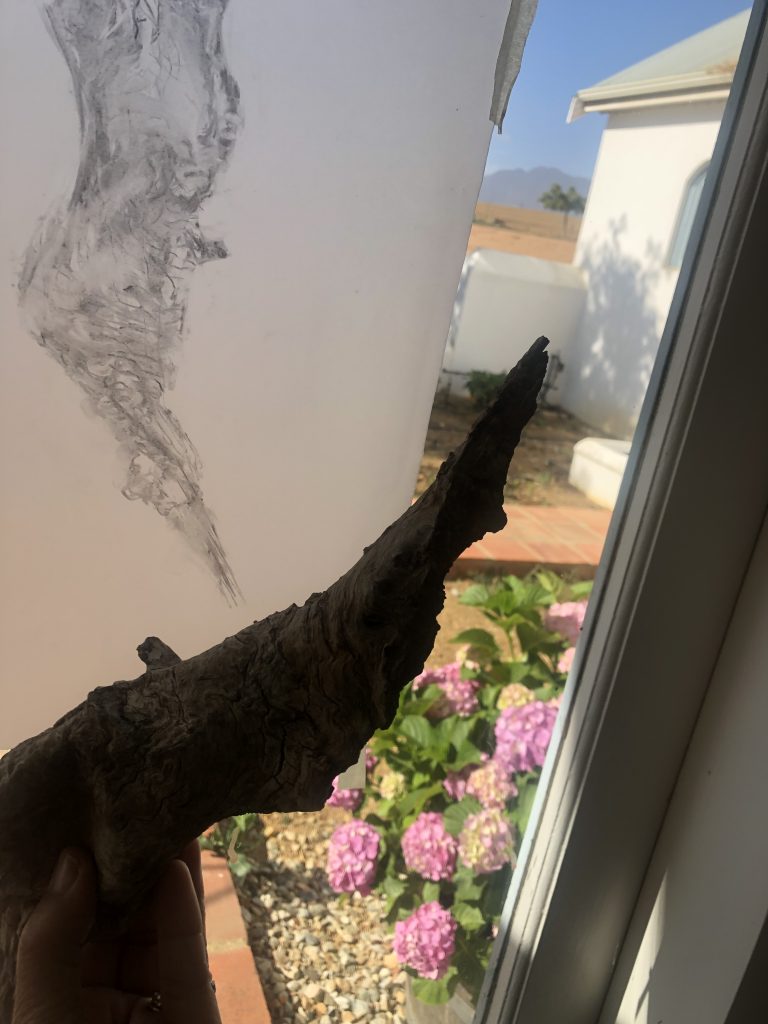
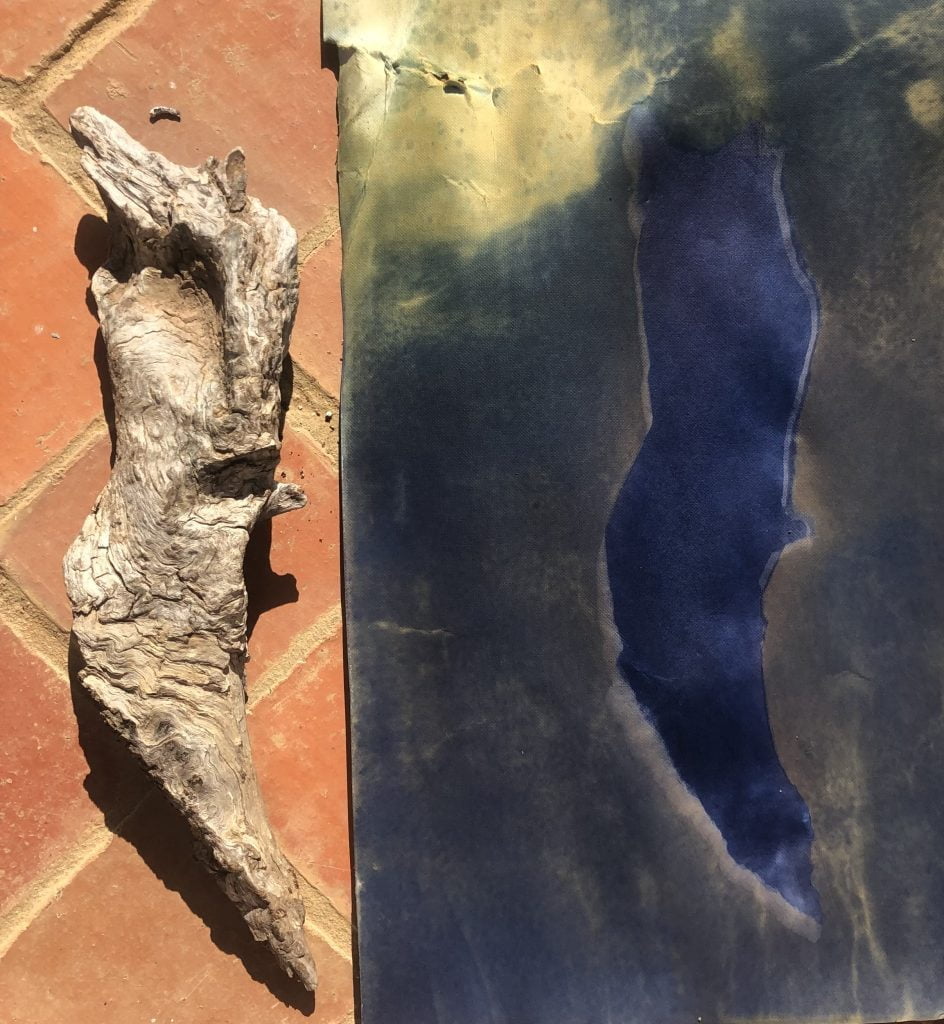

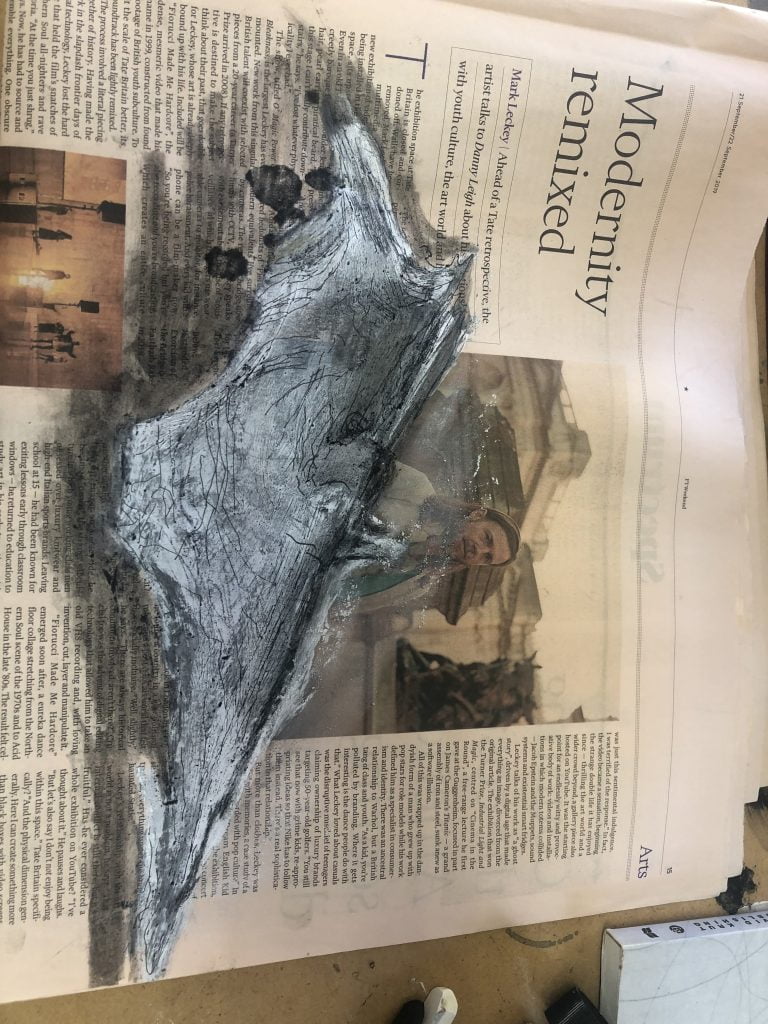
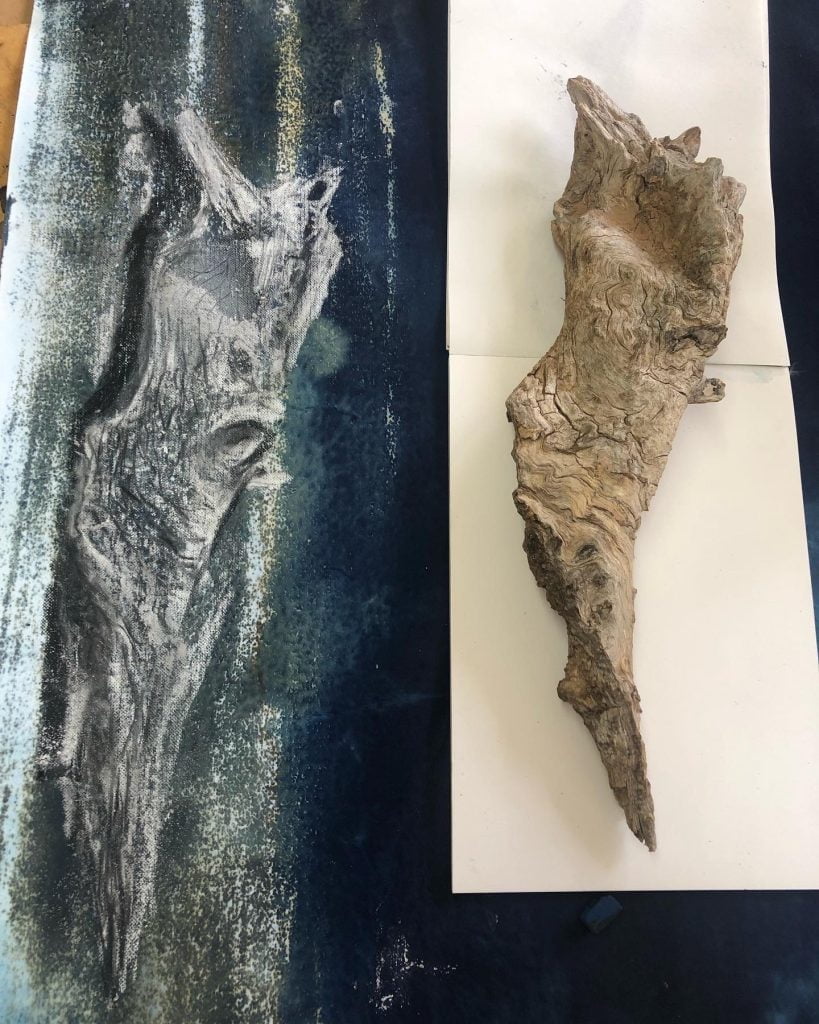
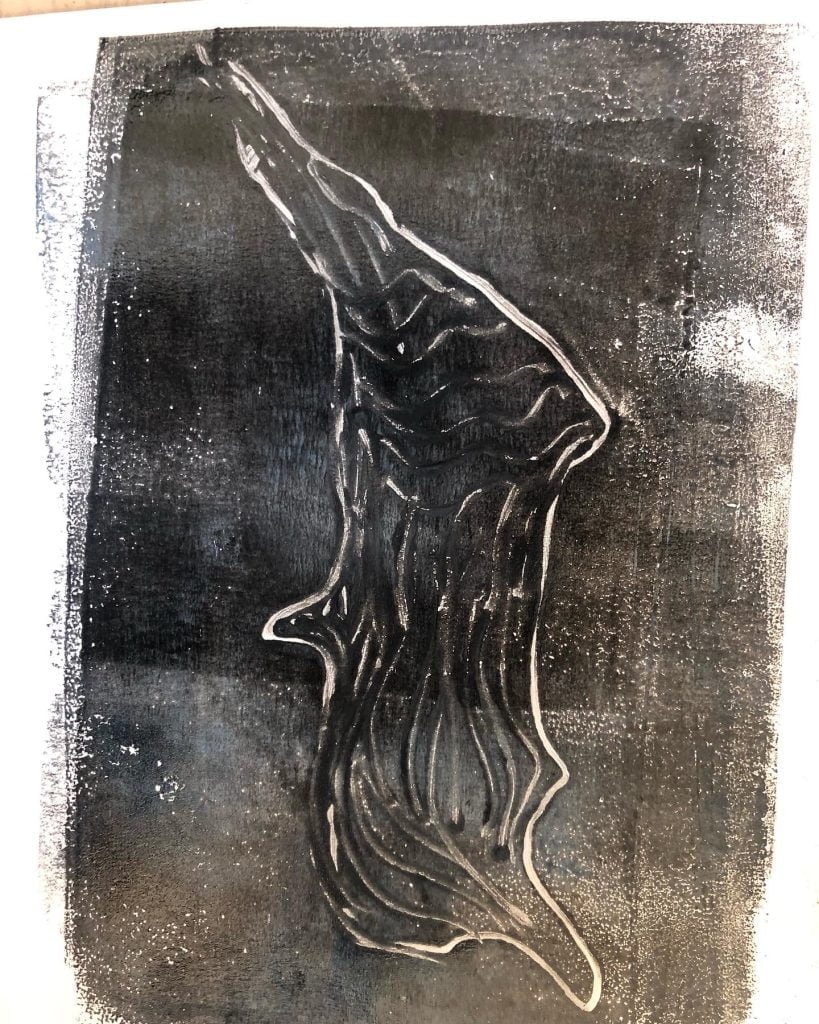

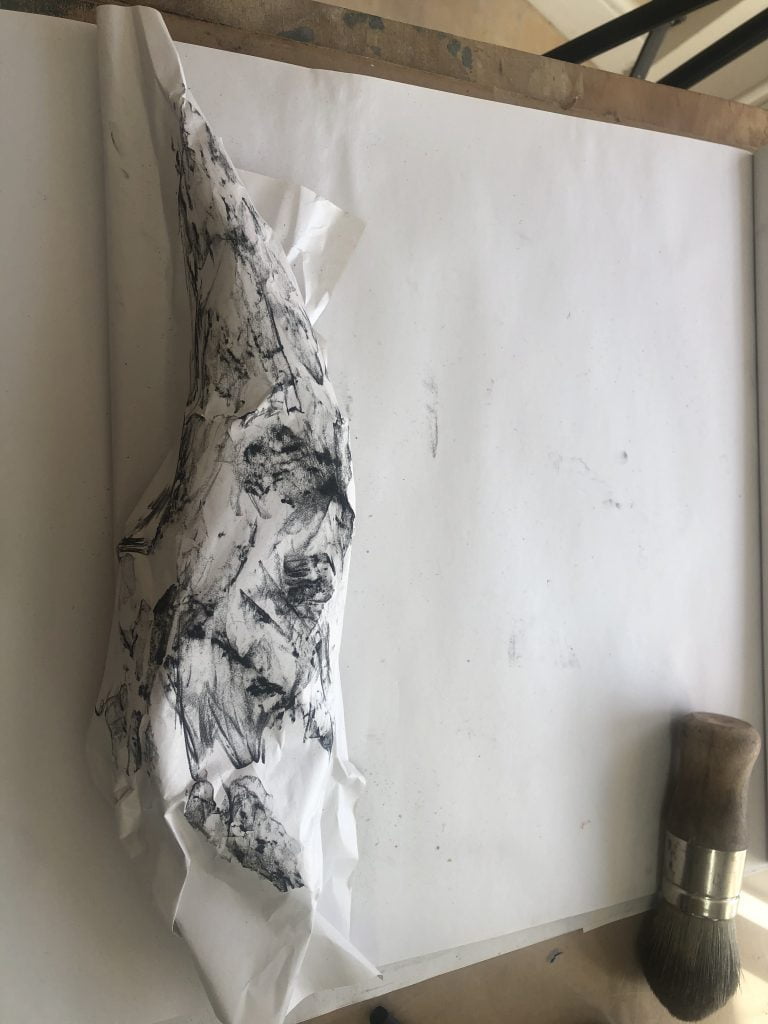
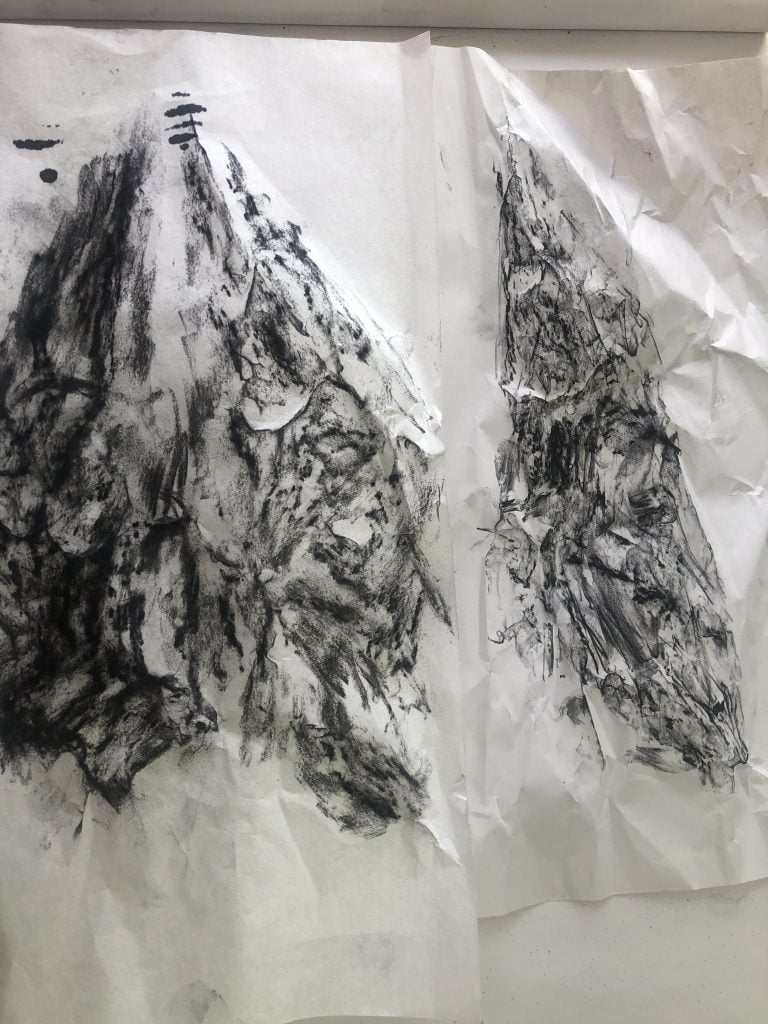
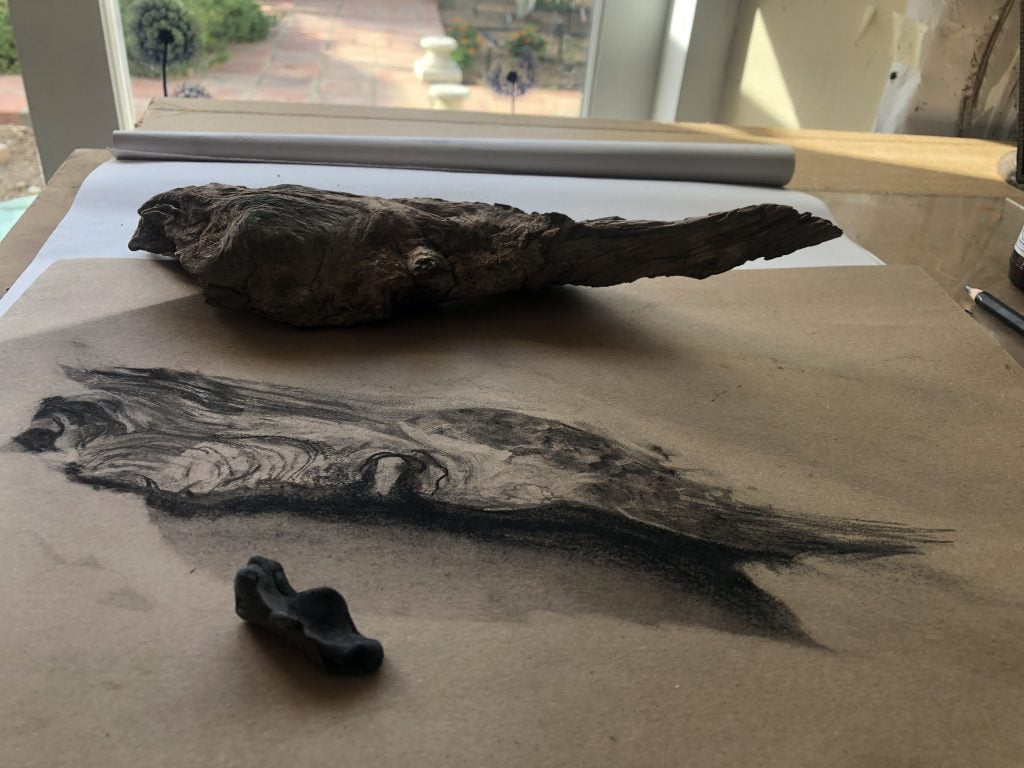
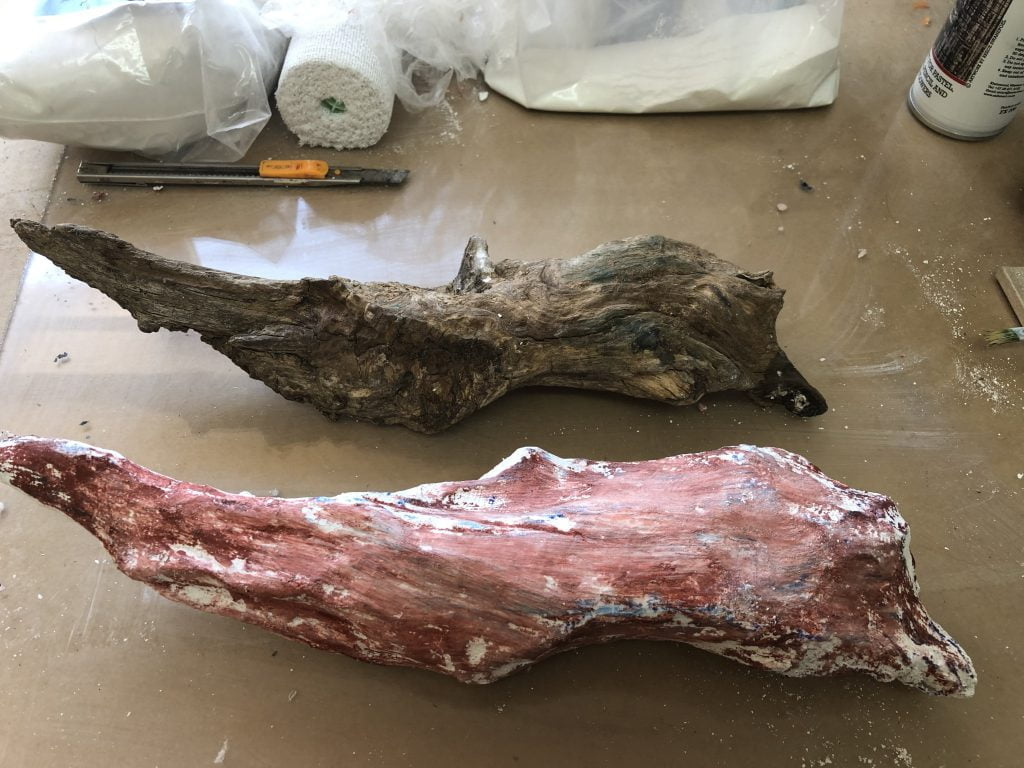
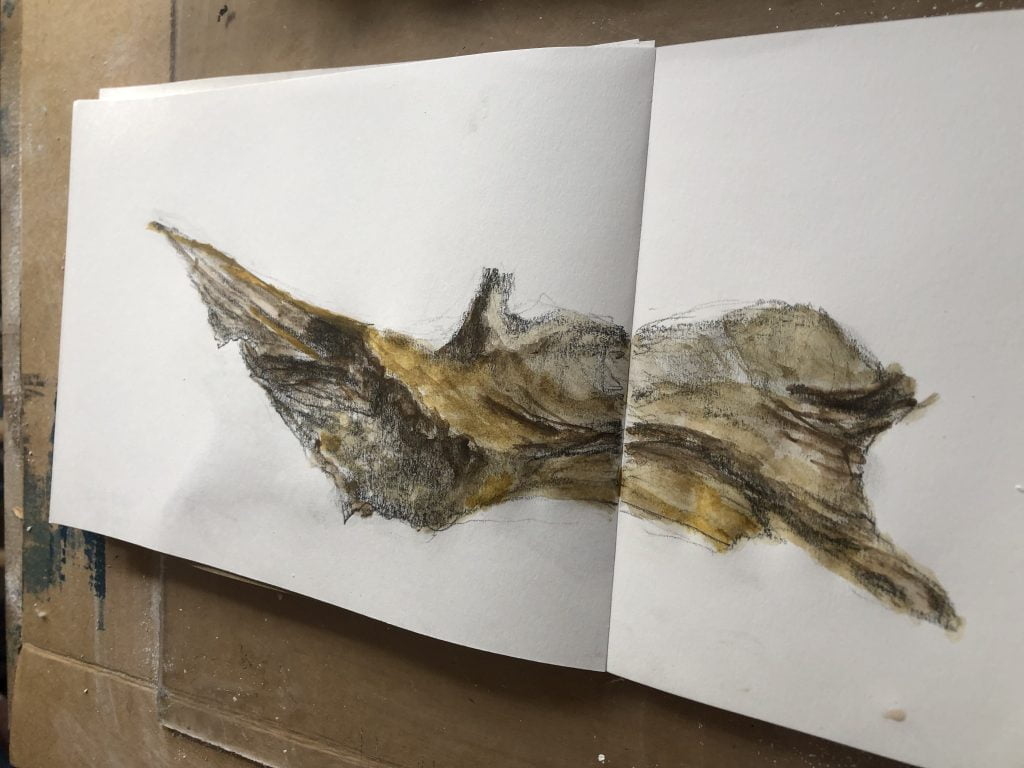
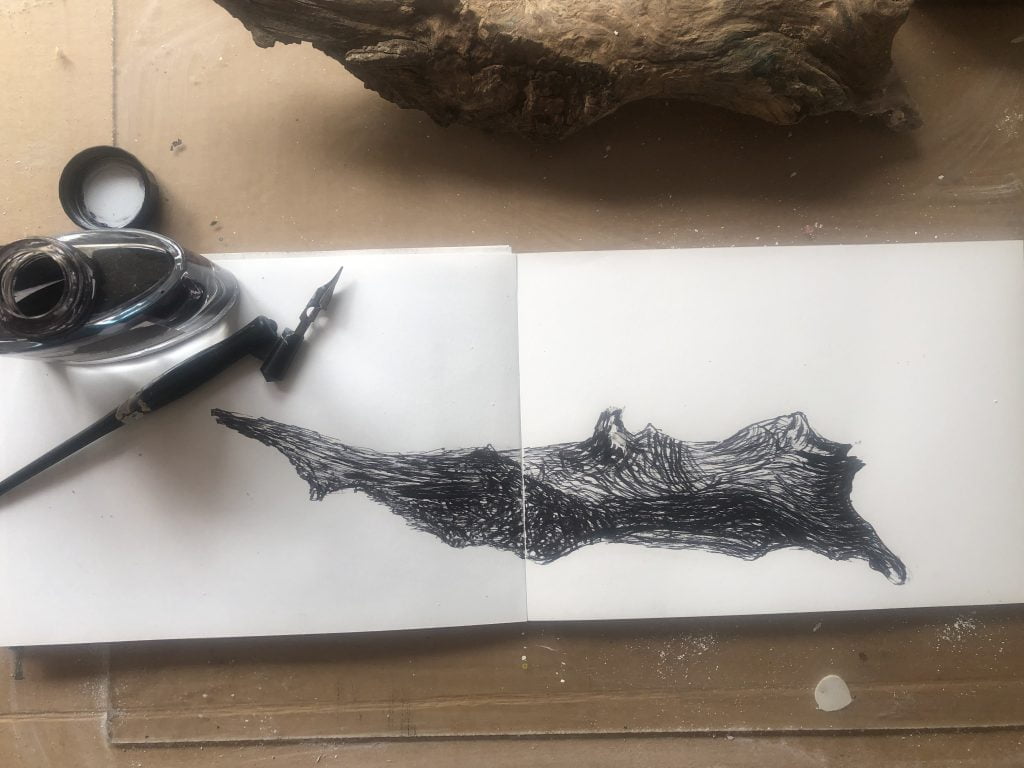
Daily drawing commitment
Halfway into the process, I joined a student crit group where we looked at the daily drawings and then discussed how we could use instruction or scores to be more creative in our making. This group consisted of students from the Europe student cohort and were from different study fields, fine art, drawing, photography, creative writing and textiles. Ideas were on the discipline to work daily importance of making consistent suggestions of other materials and approaches. I found it interesting how the object could become the subject – like using it as a drawing tool and or looking at walking and how it impacts on my creativity as well as the history of the object – to look at a map of the area where I found it – almost to give it context. We discussed how making and theory are complex for most students to bring together in one space. How we work around making and creating, and battle to contextualise this as theory. We discussed that studies/academia place high importance on knowledge and that we think making is where sensemaking in our practices happens. To me, this again made sense for why I collect things when I walk and find and look for inspiration in nature, and I want to bring this experience into my studio and practice.
Exercise 1.8: What will it do for me?
- Organise my thoughts
- Communicate my thoughts/learning/progress/process
- Informs my ideas
- Explain layers in the process
- Show questions when they raised
- Share analytical thinking
- Discuss problem-solving in the making of work
- Share lessons learned
- Space to reflect
- Space to critique
Jaimini Patel text
Drawing, Watching, Unrolling
I learned from this work that I can repeat an action but it cannot be identical. There will always be variations, which could be in duration and rhythm, and there are things outside my control that will influence the outcome. So each result or outcome stays unique, and one wonders about chance and intention. I like to think these works are investigations in to history and change and that the making is unedited and opens one up to endless possibilities within the space and objects one interact with.
I also like to think of the attention (devotion?) given to each work during observing, which one could call ephemeral propositions, almost at the brink of something happening.